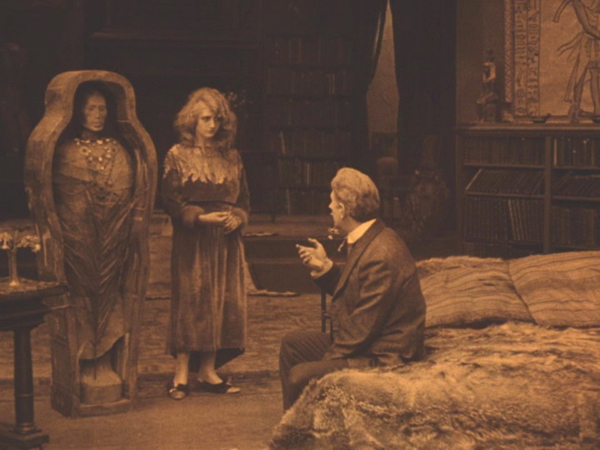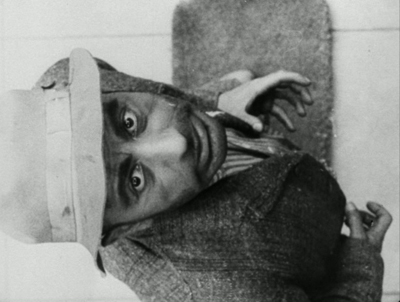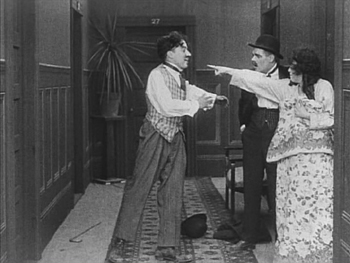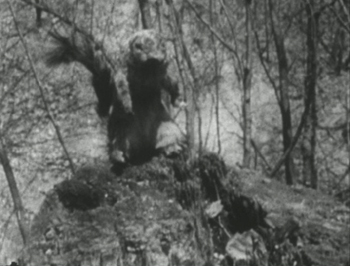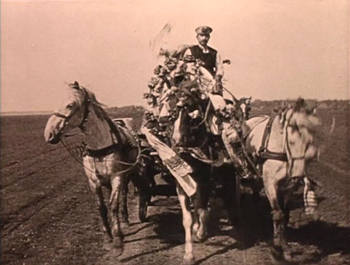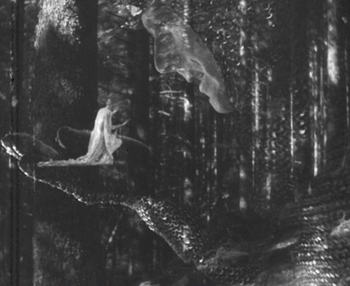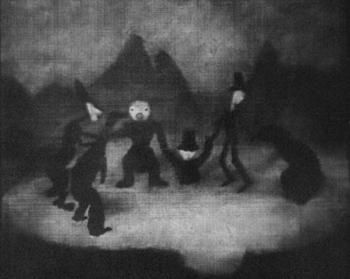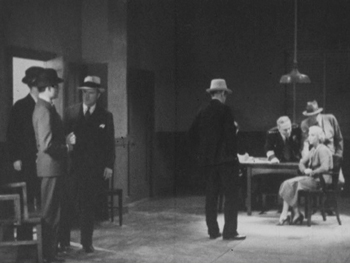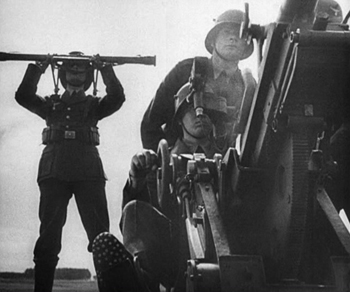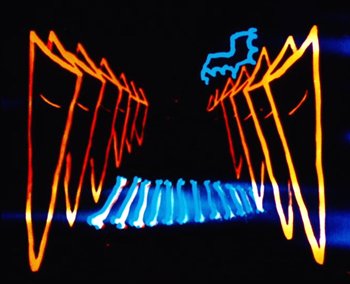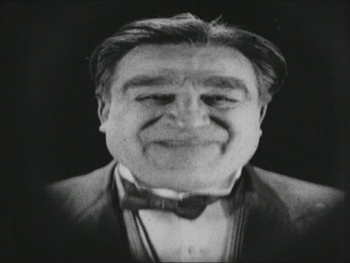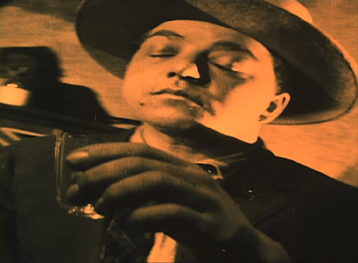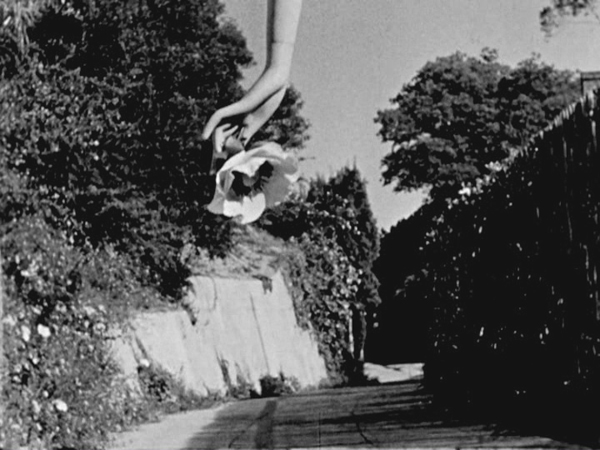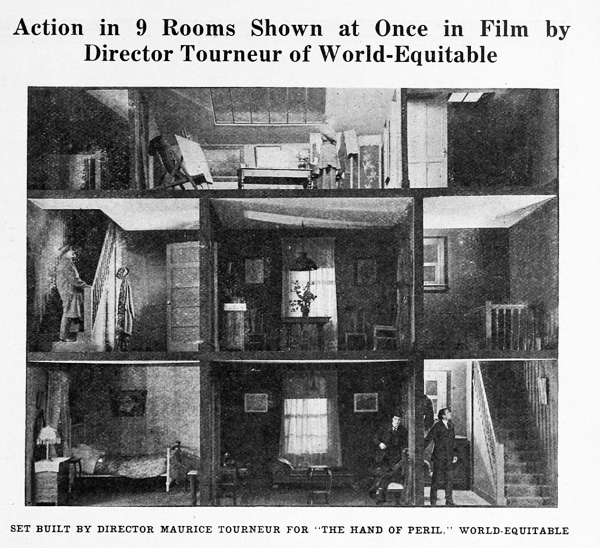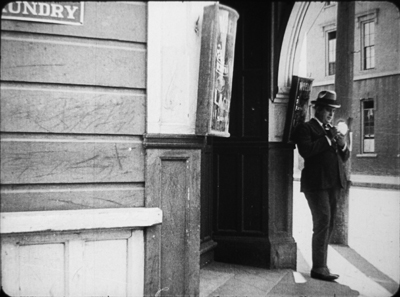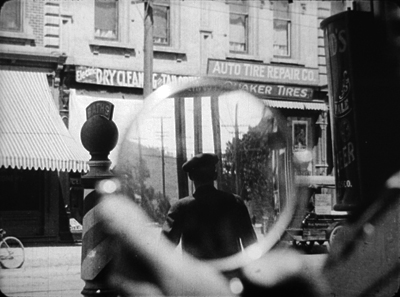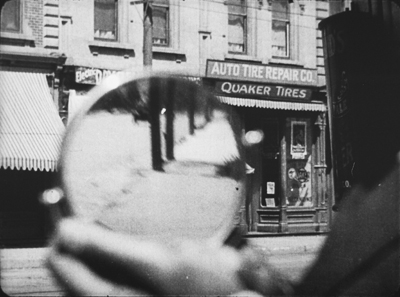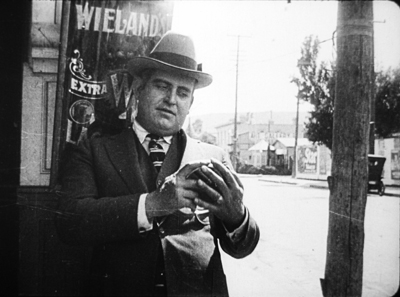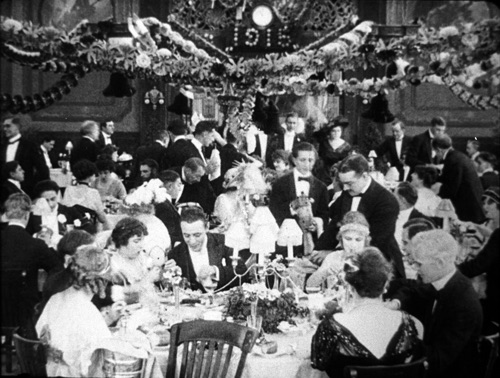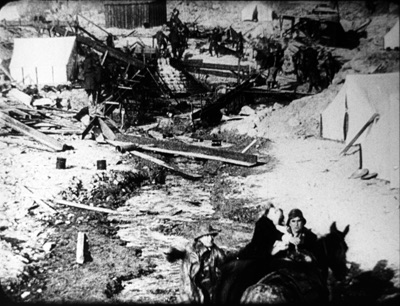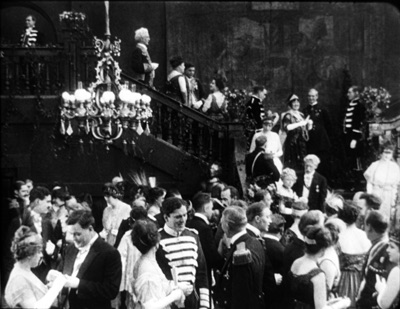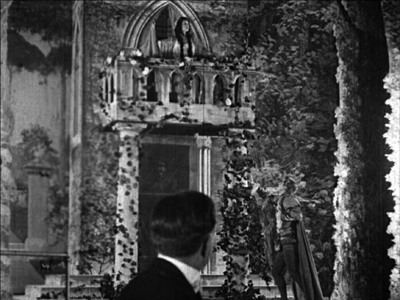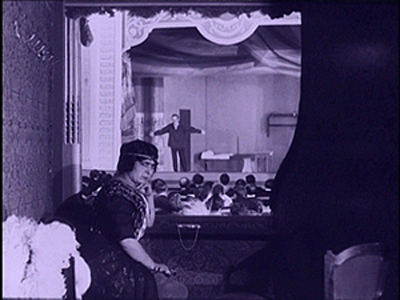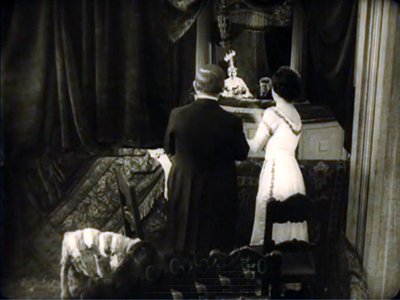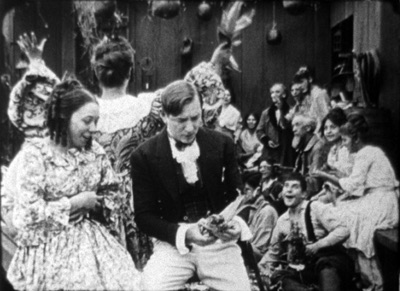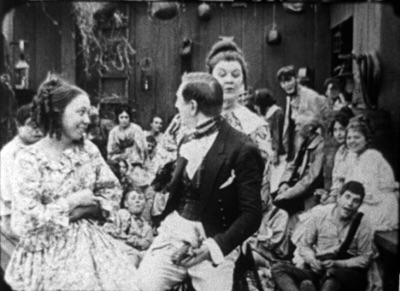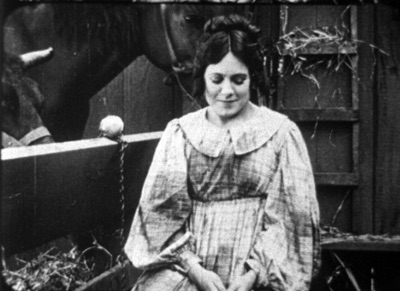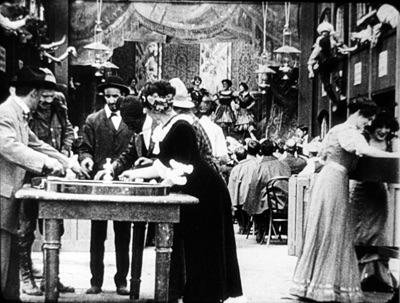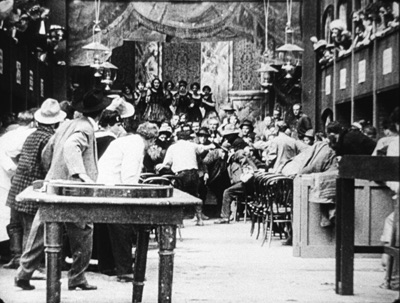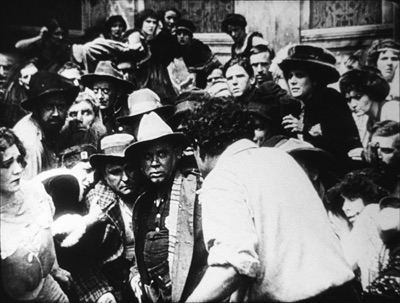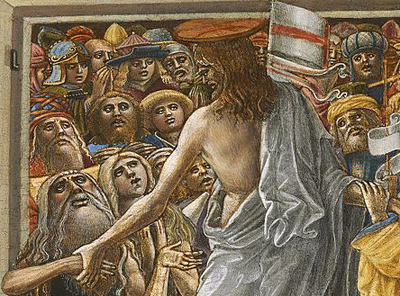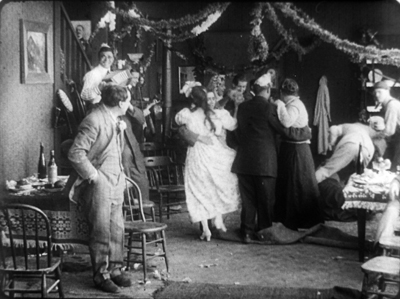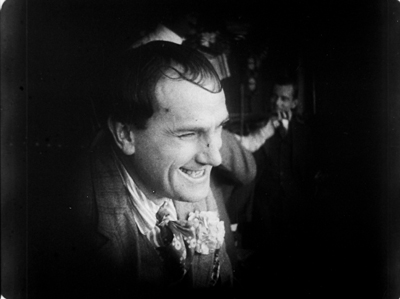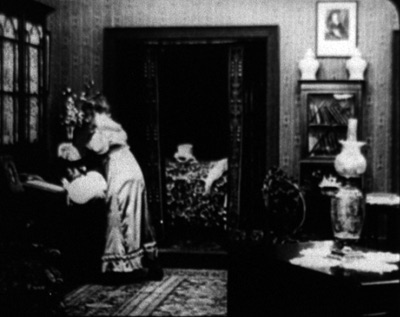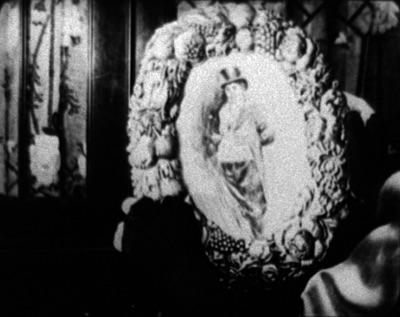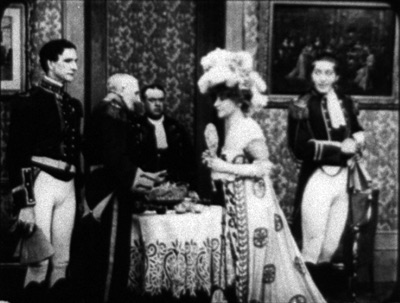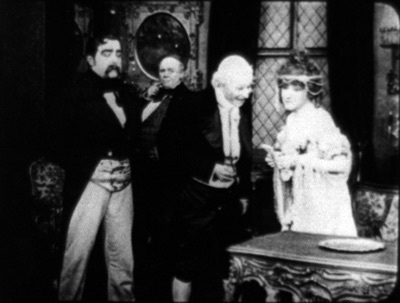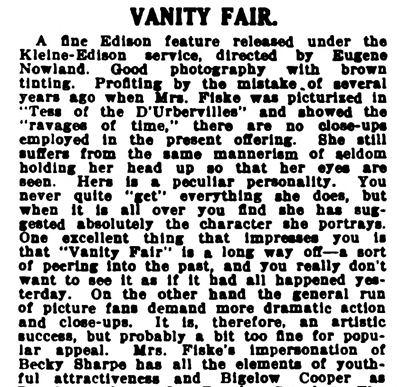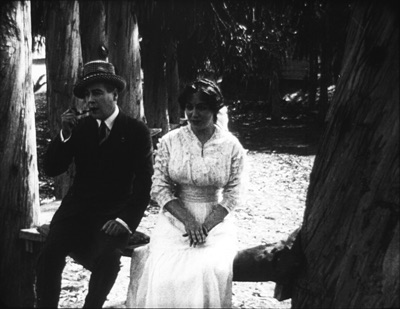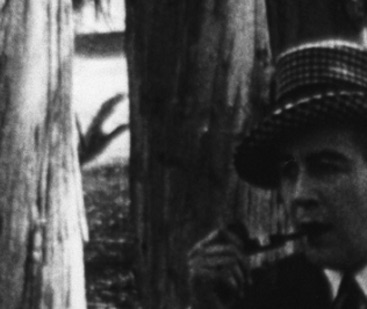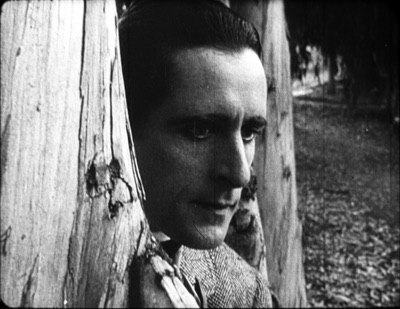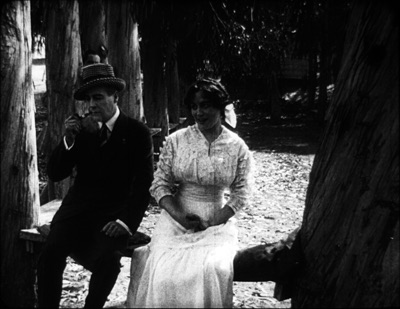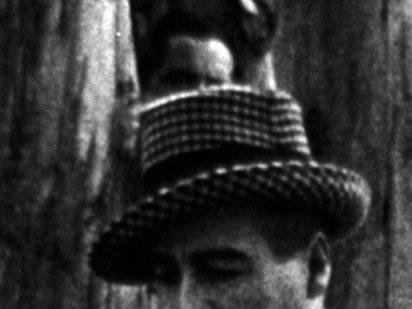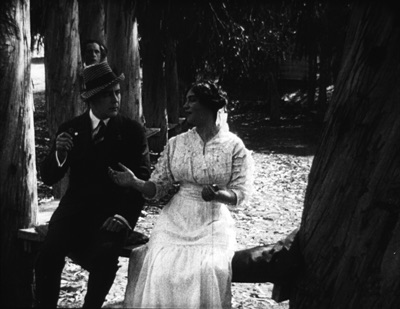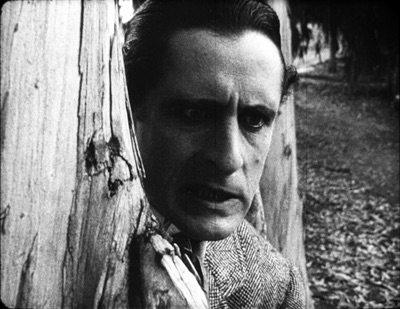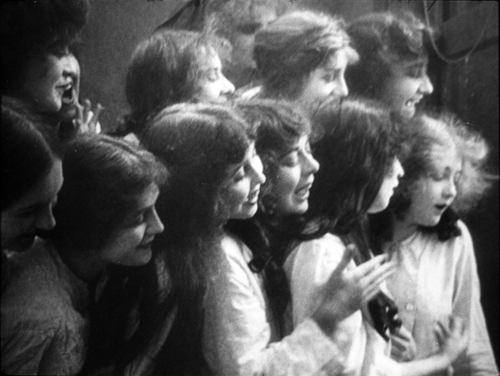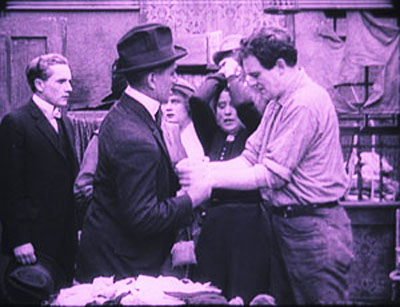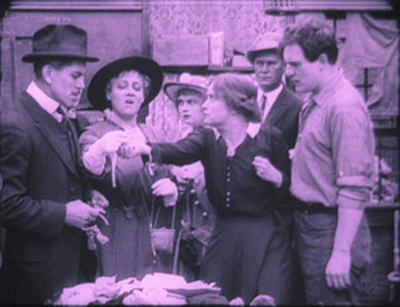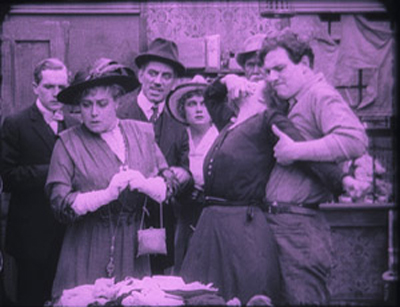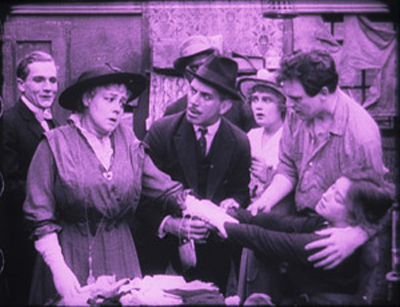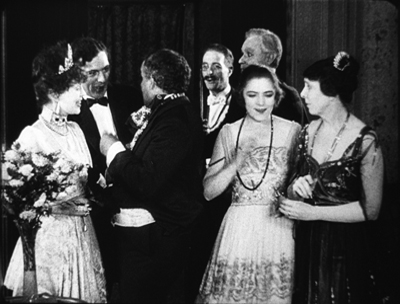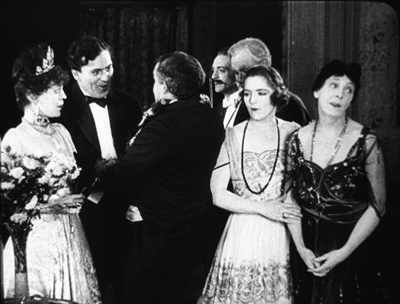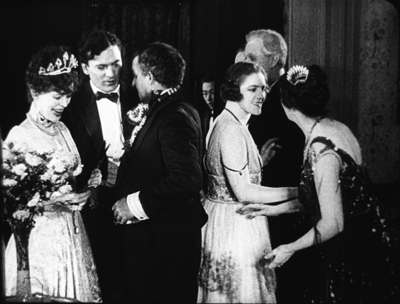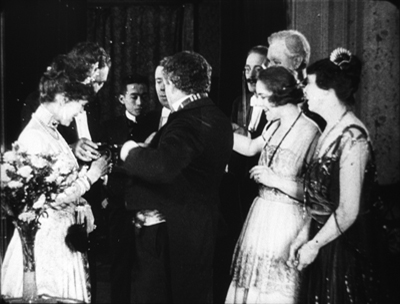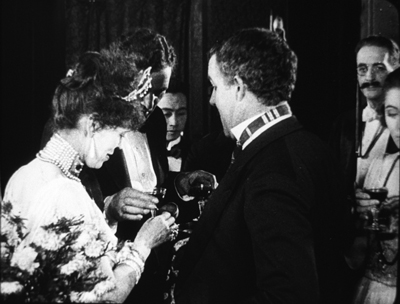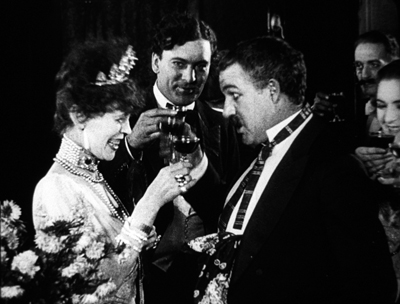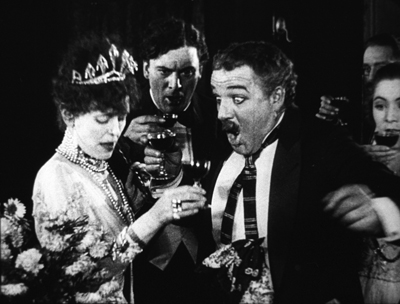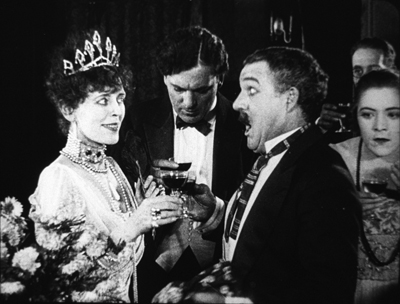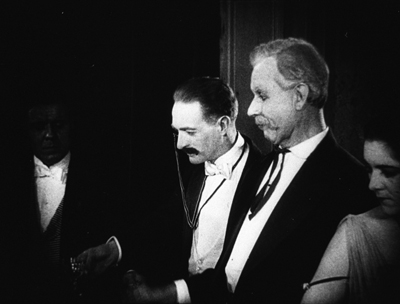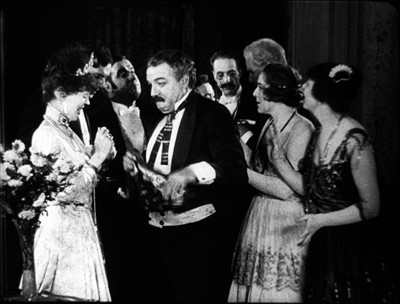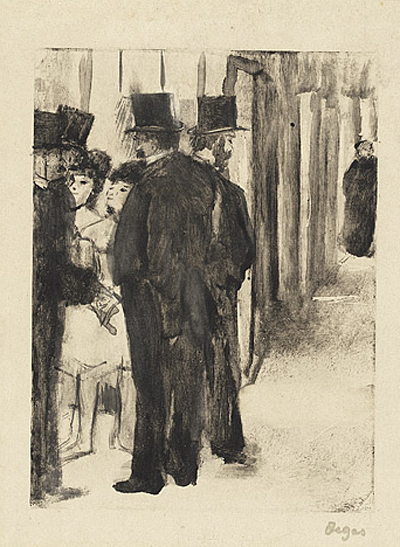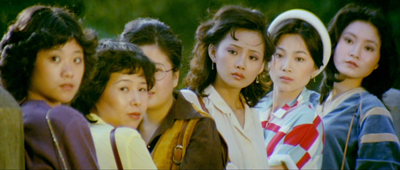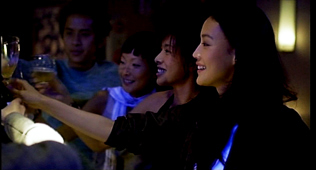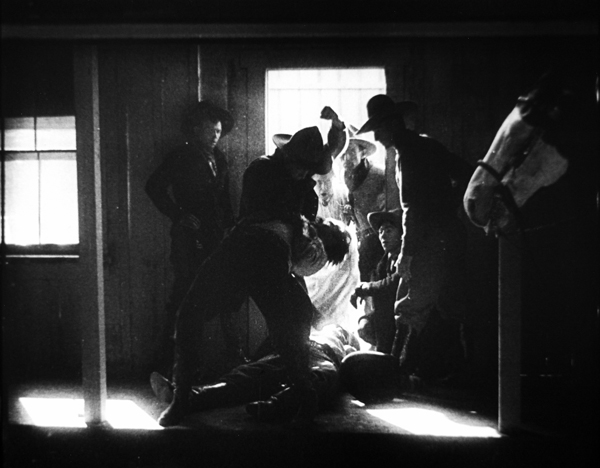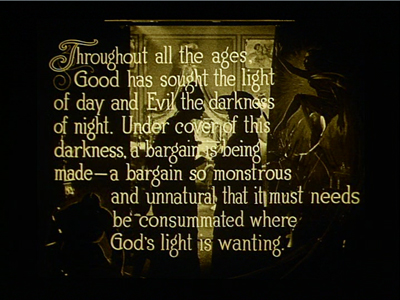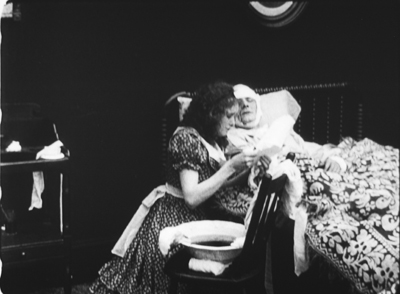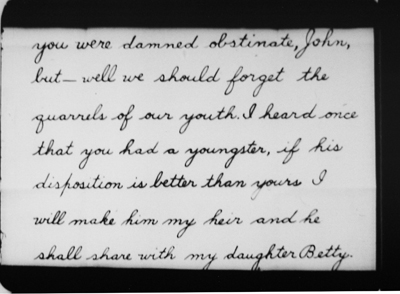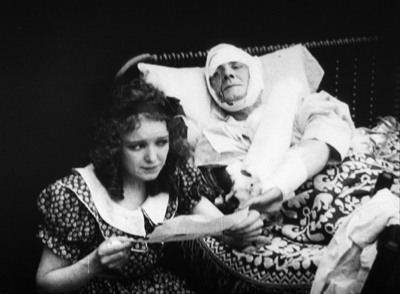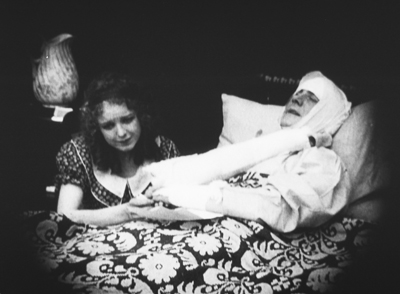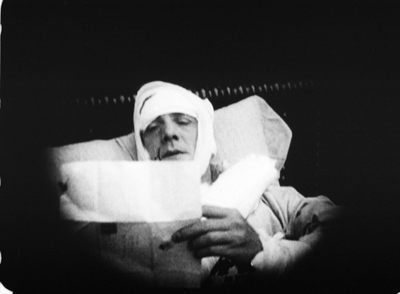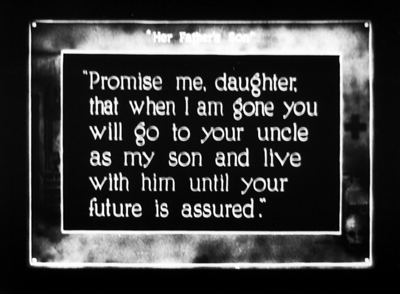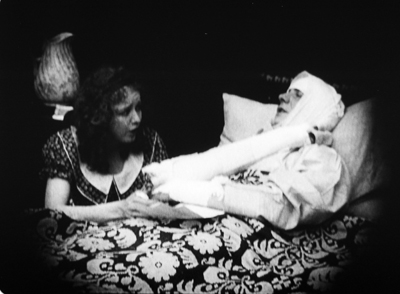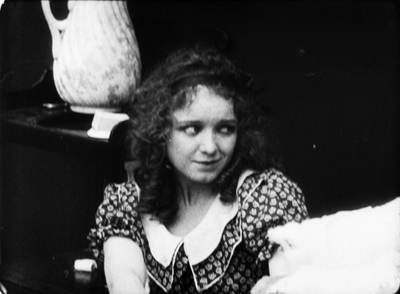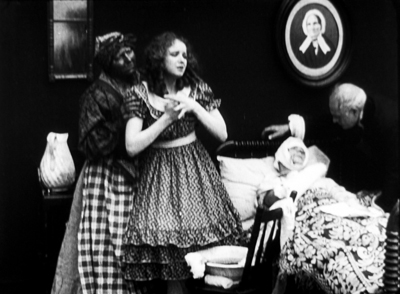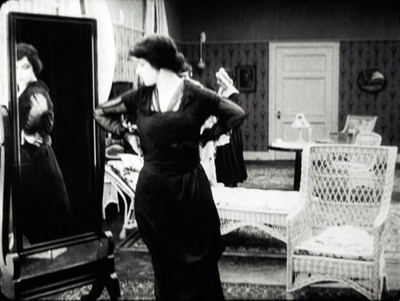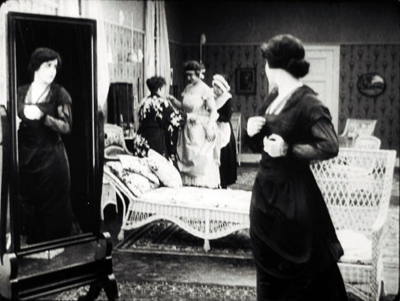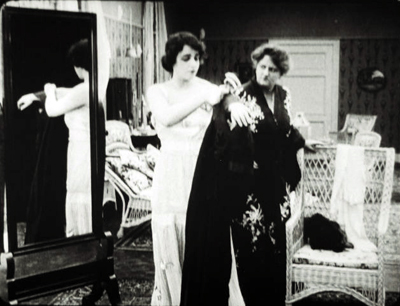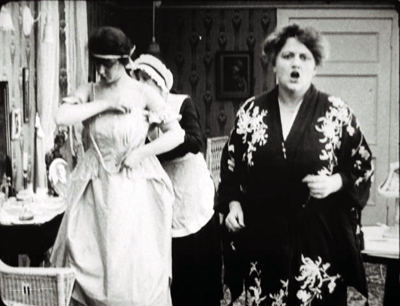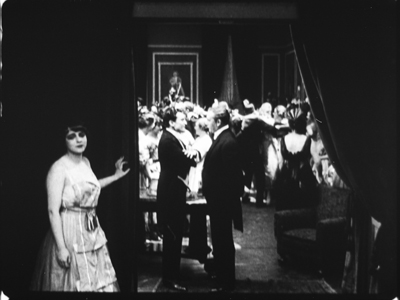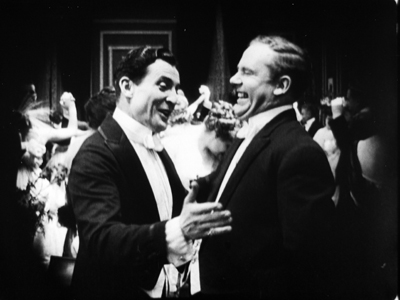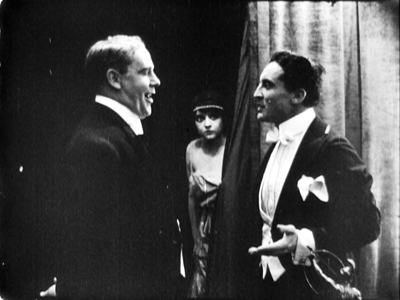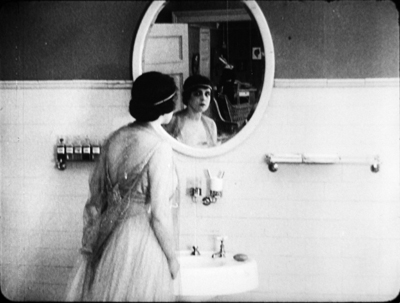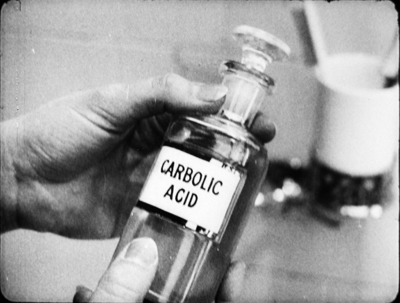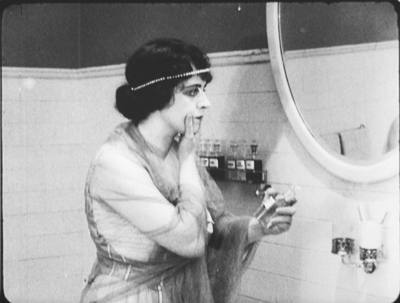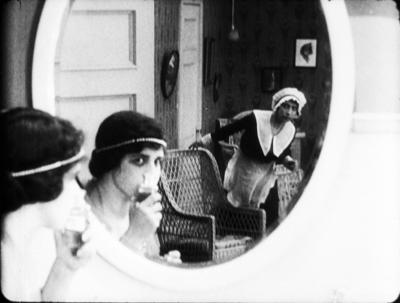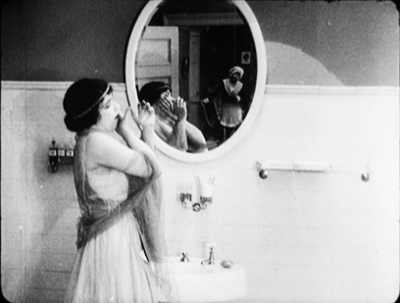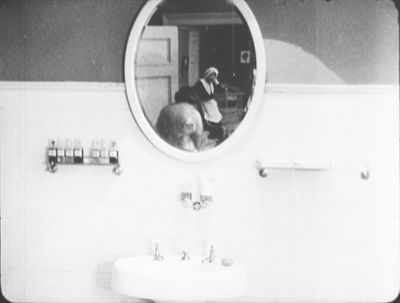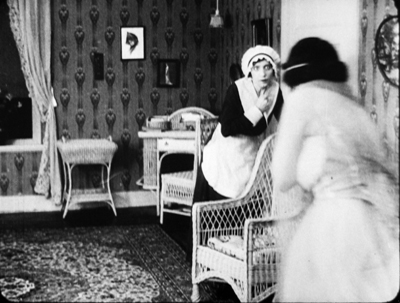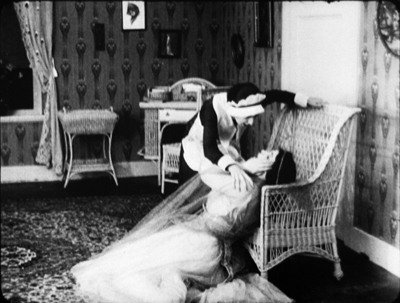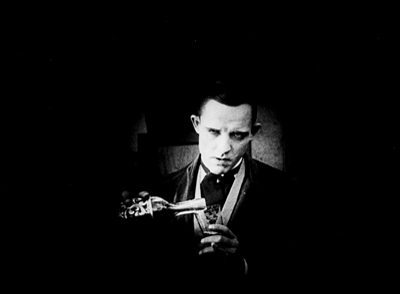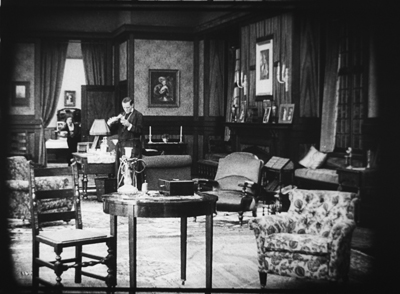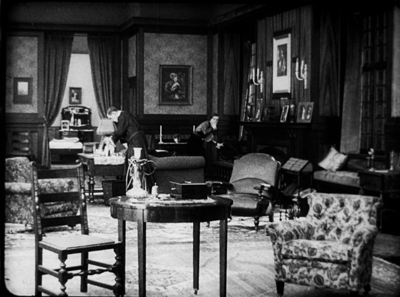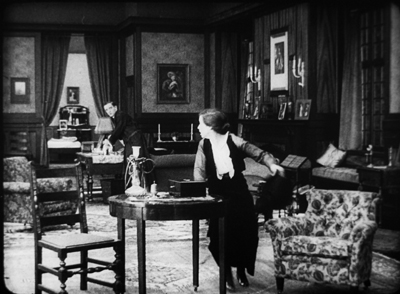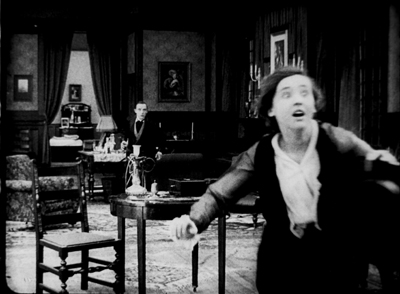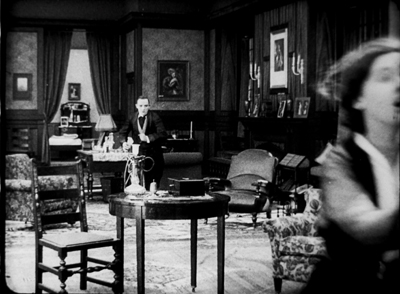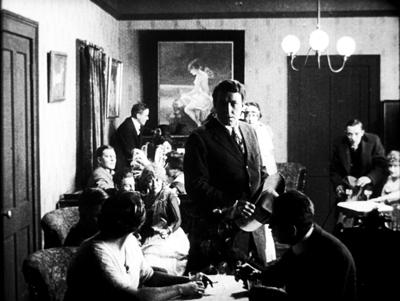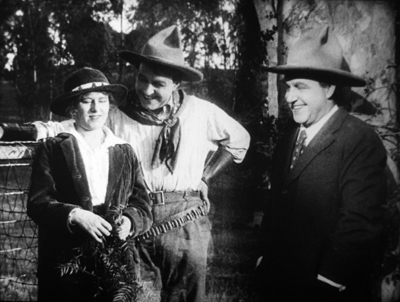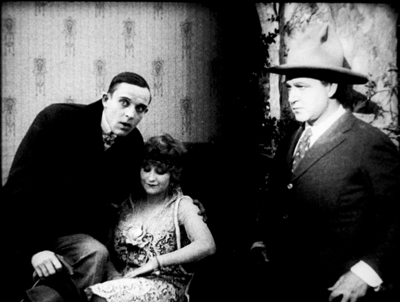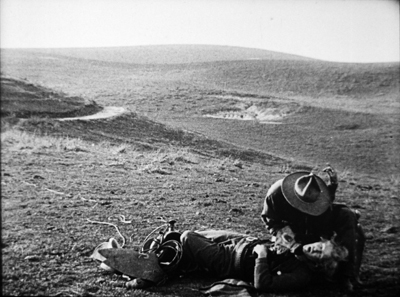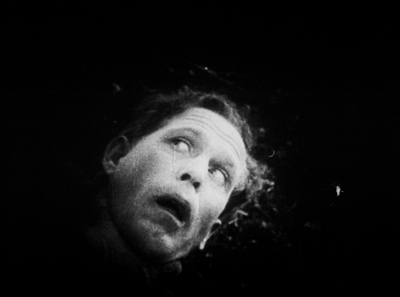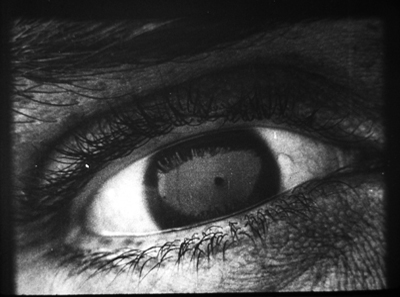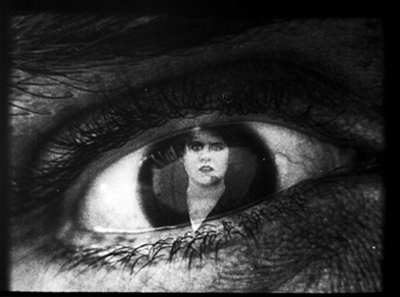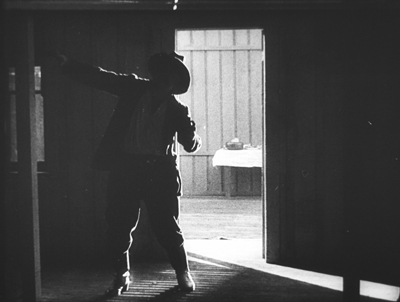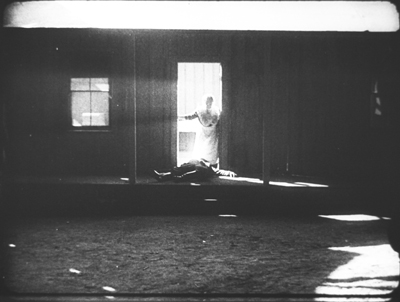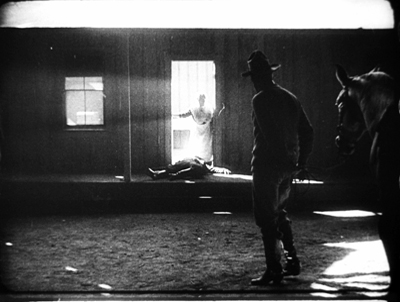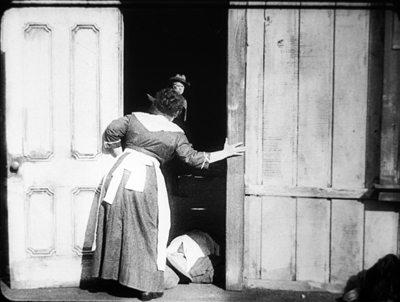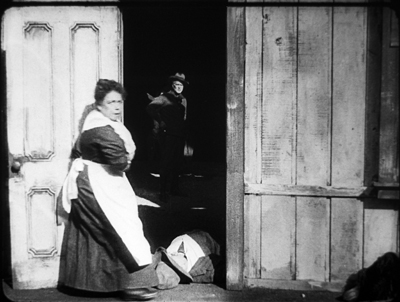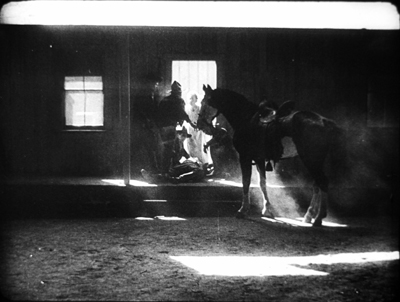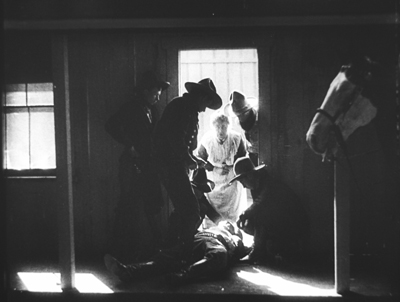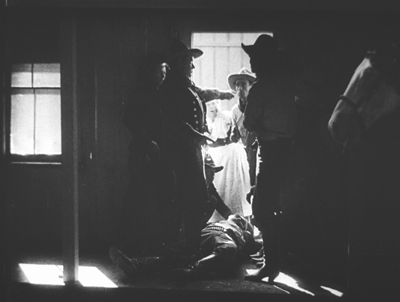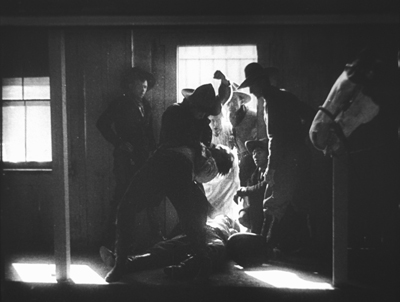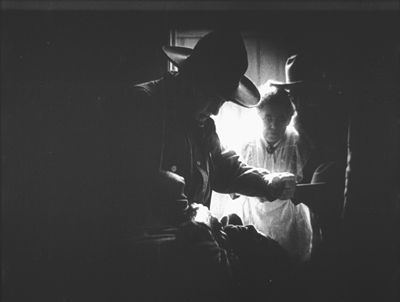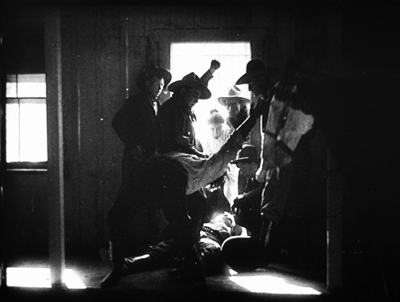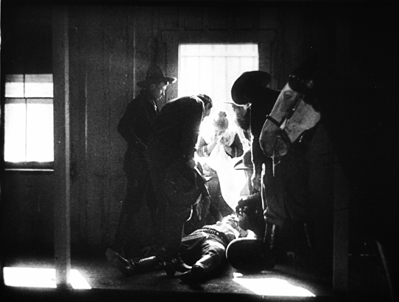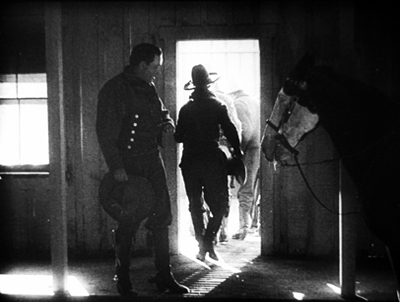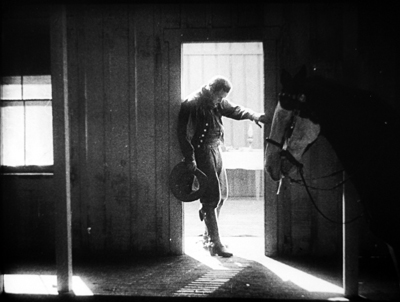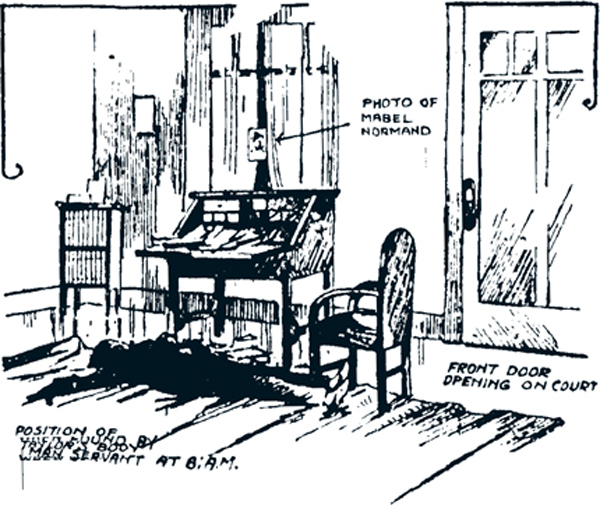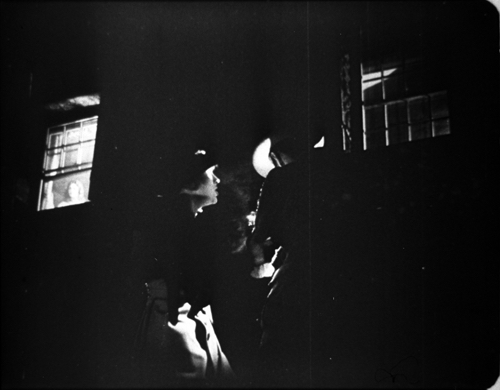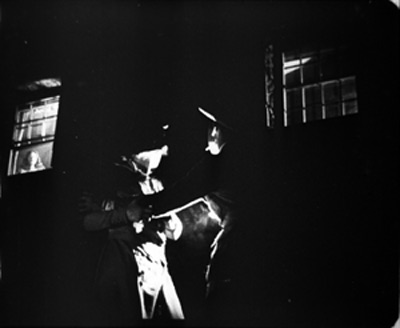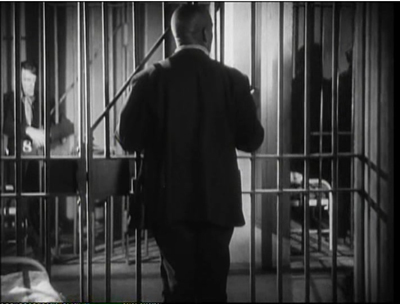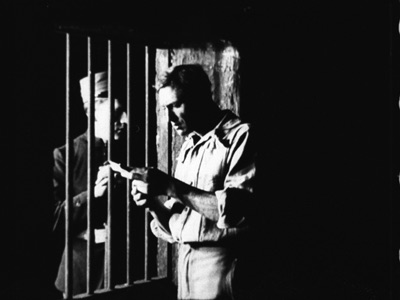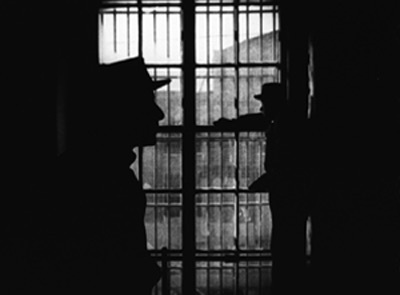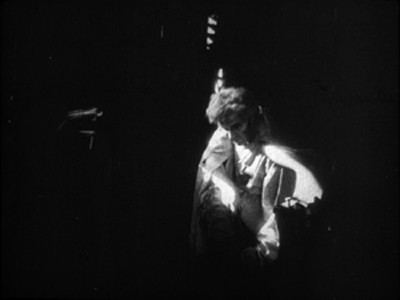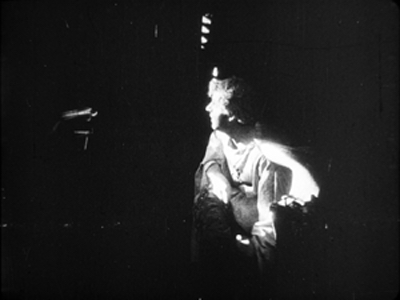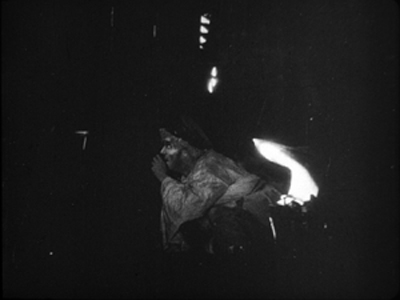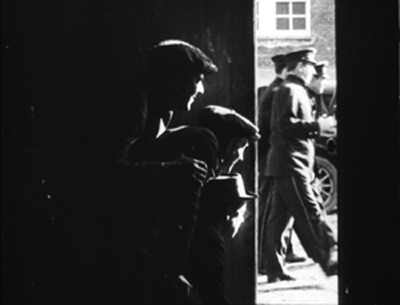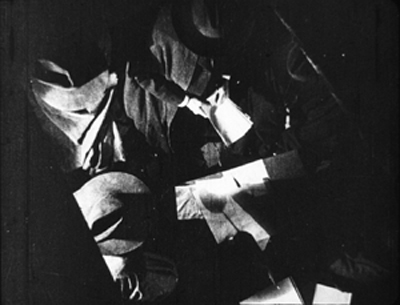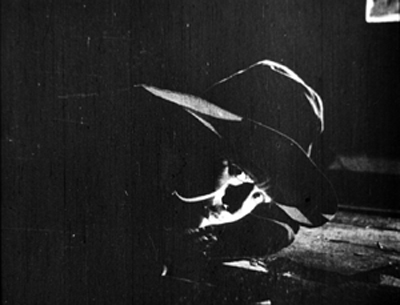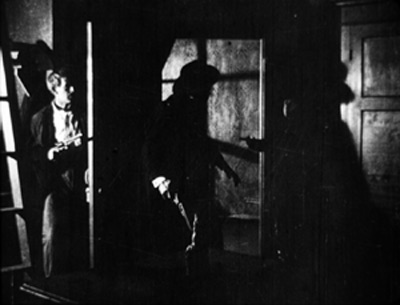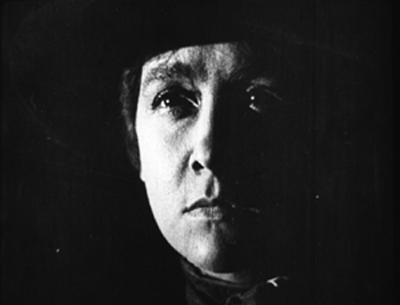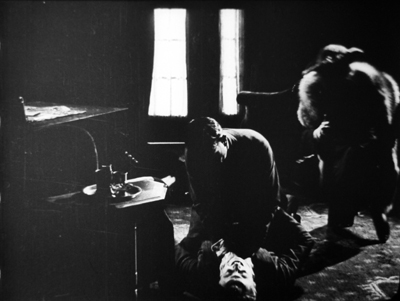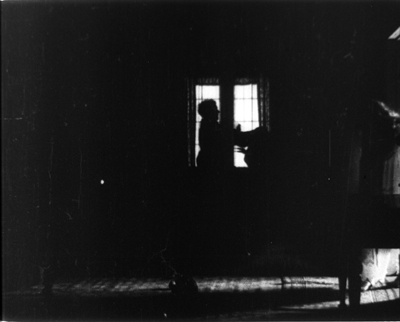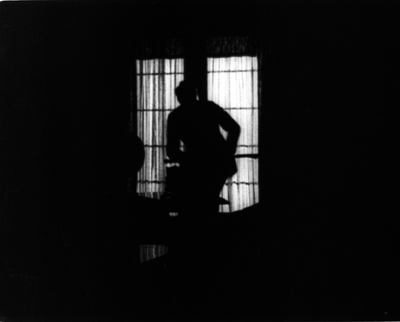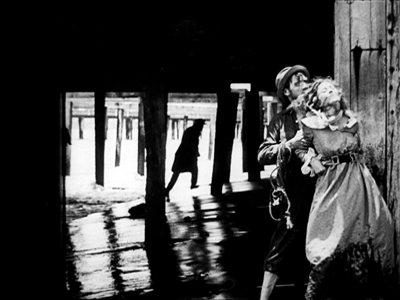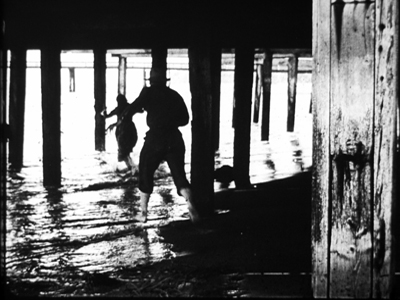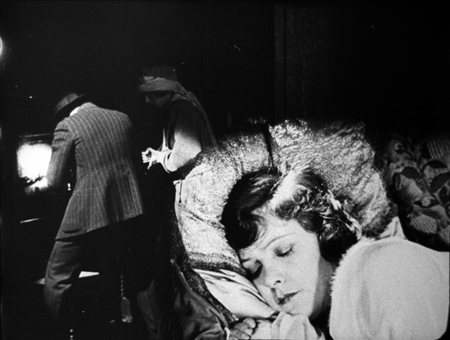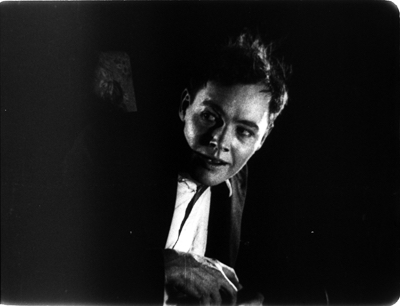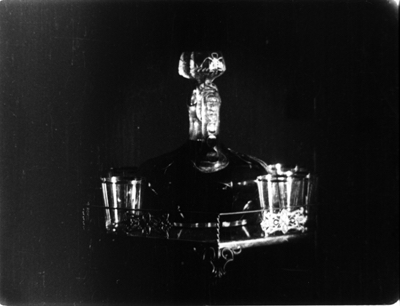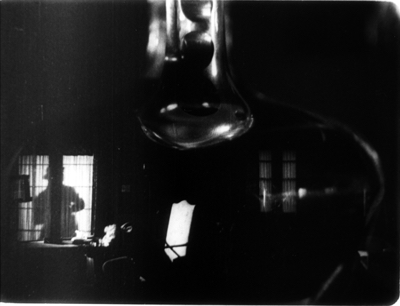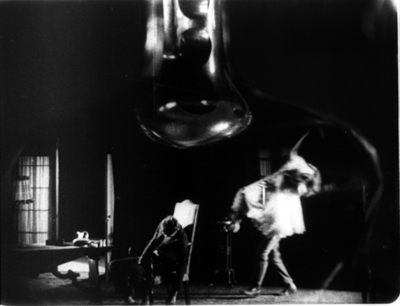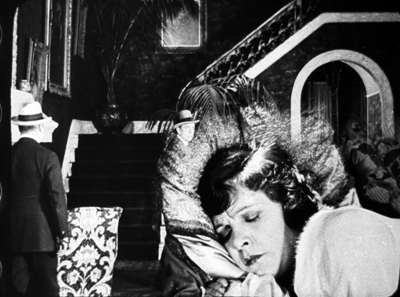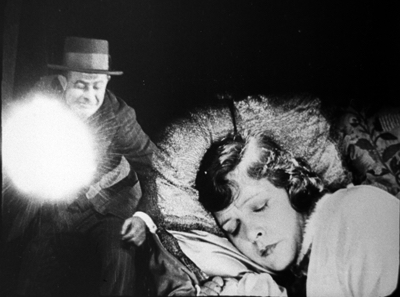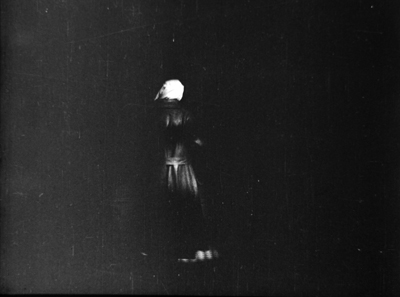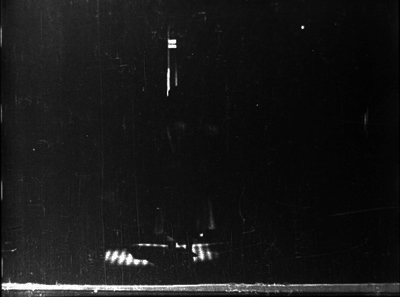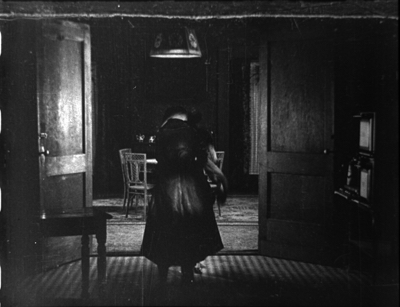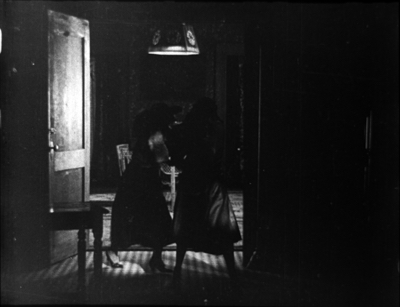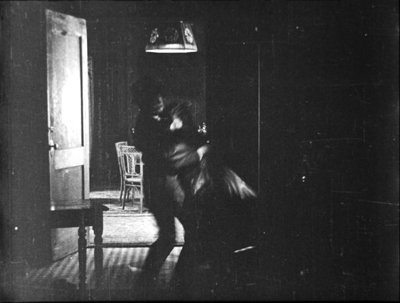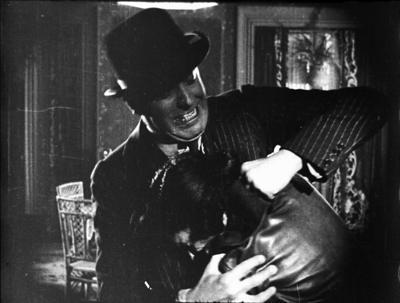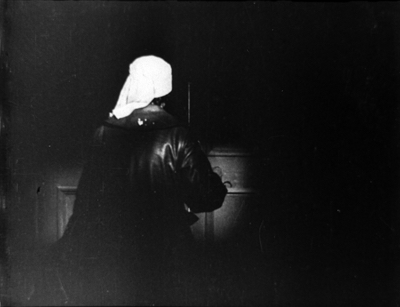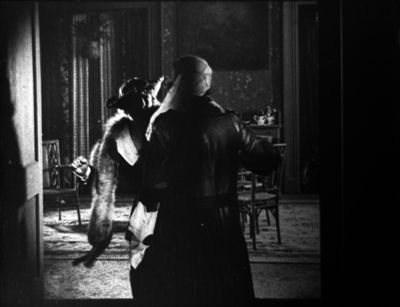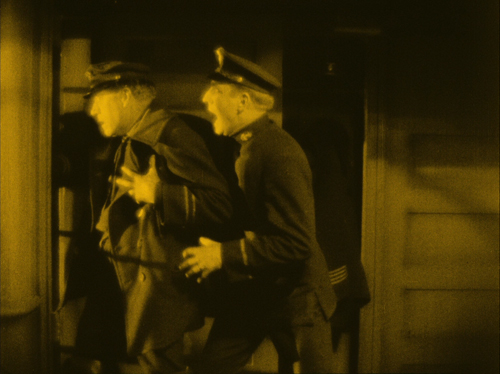Archive for the '1910s cinema' Category
Ladies at all levels
La cigarette (1919)
Kristin here:
Earlier this month Flicker Alley released another of its ambitious collections of historic films, Early Women Filmmakers: An International Anthology. The dual-format edition contains three discs DVDs and three Blu-ray discs. Its ambitions are reflected in part by the volume of material included (652 minutes) and in part by the range of its contents, from well-known classics to obscure titles.
The collection was one of the last projects curated and produced by the late David Shephard. As with many of Flicker Alley’s releases, it was a joint project with Film Preservation Associates (Blackhawk Films) and Lobster Films of Paris, working with several film archives. The films are arranged chronologically, with the earliest being Les chiens savants (1902), a music-hall dog act attributed to Alice Guy Blaché, and the latest Maya Deren’s classic experimental film, Meshes of the Afternoon (1943).
The publicity for the collection emphasizes that “More women worked in film during its first two decades than at any time since” (from the slipcase text). I would be interested in how such a claim was arrived at. It seems unlikely to me, if only because the film industries of the major producing countries have grown enormously since the silent and early sound periods. Still, despite this claim, the notes in the accompanying booklet (written by Kate Saccone, Manager of the Women Film Pioneers Project) describe how the DVD/Blu-ray release “reclaims that stature of ‘woman director’ and celebrates it in all its glory.” (One film included, Discontent [1916], is listed as “by Lois Weber”; in this case she wrote the screenplay, which was directed by Allen Siegler.) Thus the program does not survey the range of filmmaking work women performed–but such a survey would be essentially impossible. The lack of detailed credits on early films makes it difficult to determine even the director of a given film.
The silent films
It is not really possible to discuss all the films, but I’ll mention some and link to earlier entries where we’ve discussed some of them.
Of the 25 titles on the three discs, fourteen are silent. Six of these give an overview of work of Blaché, with three French films and three made after her move to the US.
Lois Weber is represented by three films, starting with perhaps her best-known work, Suspense (1913). With its unusual angles (see above), elaborate split-screen phone conversations, and action shown in the rear-view mirror of a speeding car, this is one of those films you show people to demonstrate how wonderfully inventive directors around the world became in that incredible year. I am also very fond of her feature, The Blot (1921).
The third Weber film, Discontent (1916), may surprise those familiar with her socially conscious features. In the mid-1910s Weber worked in a variety of genres. While David was doing research recently at the Library of Congress, he watched some incomplete or deteriorated Weber films that haven’t been seen widely. He wrote about False Colors here and here. Discontent is a comedy with a moral. An elderly man is living in a home for retirees, but he envies his well-to-do family. Finally they invite him to live with them, and naturally everyone ends up annoyed by the situation–including the protagonist, who winds up returning to the home and his friends.
Mabel Normand apparently directed quite a number of her films for Mack Sennett, and Mabel’s Strange Predicament (1914) is one of them. Its cast also includes Charles Chaplin and was his third film to be released, although it was the second shot and the first one in which he wore a version of his Little Tramp costume. Not surprisingly, he steals every scene he’s in. Normand even plays second fiddle to him, with her character forced for a stretch of the action to hide under a bed, where she is barely visible while Chaplin performs some funny business in the same room. (The print seems to have been assembled from two different copies, the bulk of the film being in mediocre condition with the ending abruptly switching to a much clearer image.)
One curious item in the program is Madeline Brandeis’ The Star Prince (1918). According to her page on the Women Film Pioneer’s Project, Brandeis was a wealthy woman who made films, mainly centering around children, as a hobby. Some of these were apparently intended for educational use. The Star Prince, her first film, is clearly aimed at children. A few of its adult characters are played by young adults, while children play both children and adults. This becomes a bit disconcerting when we assume for a long time that the prince and princess are perhaps seven or eight, until they fall in love and become engaged.
Despite the amateur filmmaking, there are some attempts at superimpositions and other special effects to convey the fantasy, as well as an charmingly clumsy pixillation of a squirrel puppet, the position of which is changed far too much between exposures.
This is the sort of local production, made outside the mainstream industry, that so seldom survives, and it is a welcome balance to the more sophisticated works that make up the bulk of this collection.
Speaking of which, the next part of the program consists of two features by one of the best-known female directors, Germain Dulac. The first, La cigarette, appeared in 1919. It’s melodrama about an fifty-ish Egyptologist, who has just acquired the mummy of a young princess who was unfaithful to her older husband. The professor begins to imagine that he is suffering a similar fate when his young and beautiful wife (see top) begins spending time with an athletic young fellow.
I remember seeing this film nearly forty years ago and thinking it was pretty weak. Luckily I have seen many films from this era since and know better how to watch them. Seeing it again I liked it quite a bit. It’s beautifully shot and well acted, and its sympathetic depiction of the doubting husband and the clever and resourceful wife is more subtle, in my opinion, than that of the marriage in The Smiling Madame Beudet (which is also included in this set). I was glad to have a chance to see the film again and recognize it as being among Dulac’s best work.
The silent section of the program ends with Olga Preobrazhenskaia’s The Peasant Women of Ryazan (1927). The title emphasizes that Preobrazhenskaia’s film is set in a provincial area. Ryazan, the capitol, is about 120 miles southeast of Moscow, so it is not one of the far-flung regions of the USSR. Still, it would have been distant enough at the time to have its own distinctive culture. Peasant Women gives us plenty of local costumes and customs without giving the sense of this being ethnography first and narrative second. Exotic though it may seem to us, this would have been recent history to Russians when it first came out.
Although most synopses claim that the story runs from 1916 to 1918, it actually begins shortly before World War I, probably in 1914, as the heroine Anna marries Ivan in a lively wedding scene including a carriage ride for the bridal couple (below). Shortly thereafter news of the war comes, and Ivan reluctantly departs for to serve in it. Anna is left in the household of her lecherous father-in-law, who rapes and impregnates her. The war goes on and ends, with the Revolution taking place entirely off-screen.
The second woman of the title is Wassilissa, a tougher sort, who applies to convert a decaying local mansion (we are left to assume that it was confiscated in the wake of the Revolution). She is seen at the end as being the prototype of the new Soviet woman, though Preobrazhenskaia throughout avoids hitting us over the head with overt propaganda.
The sound films
Perhaps not surprisingly, most of the directors on the third disc, devoted to sound films, are likely to be more familiar to modern viewers. Nevertheless, Marie-Louise Iribe and her film Le Roi des Aulnes (1920), were completely unknown to me. She was the niece of designer Paul Iribe and worked primarily an actress during the 1920s, and this seems to have been her only solo directorial effort. (IMDb lists her as the co-director of the 1928 version of Hara-Kiri, which she also starred in.)
Le Roi des Aulnes is one of the musically based movies that were popular in the early sound era, being based on both Goethe’s and Schubert’s versions of “Der Erlkönig.” It’s nicely photographed, and the part of the father is played by Otto Gebühr, known for being trapped by his resemblance to Friederick der Grosse into playing that role time after time from 1921 to 1941. He’s predictably excellent here, though the stretching of the short poem into a 45-minute film forces him to register worry and eventually grief throughout. Indeed, despite extrapolated incidents, such as the injury of the father’s horse and the need to procure a new one, a great deal of repetition occurs: lots of riding through marshes and menacing appearances by the Erlkönig, who is portrayed as a large man in chain-mail.
The special effects are the most impressive thing about the film, using double superimpositions in widely different scales, with the giant king holding a small fairy on his palm.
Despite its problems, the film is a valuable addition to our examples of this mildly avant-garde trend that flourished for a short time.
Most of the rest of the directors are well-known and can be mentioned more briefly.
The great animator and innovator of silhouette animation Lotte Reiniger is represented by three short films: Harlequin (1931), The Stolen Heart (1934), and Papageno (1935). I have written about Reiniger’s complex compositions, including her subtly shaded backgrounds. Of the directors represented here, she is the one who enjoyed the longest career, from 1916, when she would have been 17, to 1980, when she was 81. I discuss a BFI boxed set of some of her 1950s films here. I haven’t been able to find a complete filmography, but William Moritz estimates that she made “nearly 70 films.”
Alexandre Alexeieff and Claire Parker’s A Night on Bald Mountain is similarly familiar. Like Iribe’s Le Roi des Aulnes, it falls into the genre of illustrations of existing musical pieces, being an illustration of a piece of the same name by Modest Mussorgsky, as arranged by Nikolay Rimsky-Korsakov. It was created by manipulating hundreds of pins on a large frame called a pinboard, invented by Alexeieff, his first wife Alexandra Grinevsky-Alexeieff (whom he divorced in order to marry Parker in 1940), and Parker. The textured effect is quite unlike that of any other type of animation.
Dorothy Davenport was a prolific actress from 1910 to 1934. She is perhaps most remembered as the widow of Wallace Reid, a star who died from the effects of morphine in 1923. She directed seven films over the next decade, ending with the film in this set, The Woman Condemned (1934), mostly either uncredited or signing herself Mrs. Wallace Reid.
The Woman Condemned is a B picture, produced independently and distributed through the states’ rights system. It’s a competently done murder mystery that gains some interest by withholding a great deal of information from the audience. There are two main female characters, the victim and the accused (seen below in an interrogation scene), and we have very little idea of their motives and goals until the climax of the film. The revelations involve a twist on the same level of groan-worthiness as “and then she woke up.” But again, having a little-known B picture adds to the wide variety of films presented here.
One can hardly study early women directors and skip over the favored documentarist of the Third Reich, Leni Riefenstahl. Day of Freedom (1935) is a good choice for inclusion, occupying only 17 minutes of screen time and amply demonstrating Riefenstahl’s undeniable gift for creating gorgeous images from ominous subjects.
Experimental animator Mary Ellen Bute is represented by two contrasting abstract shorts, the lovely black-and-white ballet of shapes, Parabola (1937) and the vibrant and humorous Spook Sport (1939), the latter (below) made with the collaboration of Norman McLaren.
Dorothy Arzner, the only woman to direct mainstream Hollywood A films from the 1930s to the and 1940s, is introduced via a clip from one of her most famous films, Dance, Girl, Dance (1940). In the scene, Maureen O’Hara’s character interrupts her dance routine to tell off an audience of mostly men who are cat-calling her.
Maya Deren’s first film, Meshes of the Afternoon (1943) ends the program (see bottom). It is a happy choice, since of all the films in the program, it has undoubtedly had the greatest influence on the cinema. Much of the subsequent avant-garde cinema has turned away from music-inspired abstraction and opted for ambiguity, psychological mystery, and impossible time, space, and causality.
Valuable though this collection is, I cannot help but think that some of the directors represented have been oversold. Saccone sums them up:
Together, these 14 early women director have produced bodies of work that are inspiring, controversial, challenging, invigorating, and thought provoking. These women were technically and stylistically innovative, pushing narrative, aesthetic, and genre boundaries.
Surely not all of them meet these criteria. We would hardly expect one hundred per cent of the male directors of the same era to be “technically and stylistically innovative,” so why should we expect all of the work by fourteen varied female directors to be so? Saccone quotes Tami Williams’ book, Germaine Dulac: A Cinema of Sensations. on how the director searched “for new techniques that, in the light of official discourse of governmental and social conservatism, and the modernity of the new medium, were capable of expressing her progressive, antibourgeois, nonconformist, and feminist social vision.” Saccone sees this search in The Smiling Madame Beudet, where “Dulac utilizes cinema-specific techniques such as irises, slow motion, distortion, and superimposition, as well as associative editing, to give visibility to the inner experiences and fantasies of an unhappily married woman …”
Readers might infer that Dulac innovated these techniques. Yet they had already been established as conventions of French Impressionist cinema, notably in Abel Gance’s J’accuse (1919) and La roue (1922) and Marcel L’Herbier’s El Dorado (1921). For example, Dulac surely derived the distorted image of Beudet that conveys his wife’s disgust (below left) from a similar shot of a drunken man in El Dorado (right).
This is not to say Dulac isn’t a fine filmmaker or that she had no new ideas of her own. Only that she didn’t single-handed discover these techniques, but rather she turned the emerging repertoire of Impressionist techniques toward portraying a woman’s experience.
In some cases films that were co-directed by these women are presented as their sole efforts. Lois Weber’s Suspense was directed, as were many of her early shorts, with her husband, Phillips Smalley. Quotations from interviews with both Weber and Smalley make this clear. In 1914, Smalley said of his wife, “She is as much the director and even more the constructor of Rex pictures than I.” “Even more” because Weber often wrote the screenplays for their films and in at least some cases edited them. Weber later described how Smalley worked from her scripts: “Mr. Smalley got my idea. He painted the scenery, played the leading role and helped direct the cameraman.” Directing the cameraman is part of the job of a director.
The list of films in the booklet attributes Night on Bald Mountain entirely to Claire Parker, though on the backs of the disc cases the credit is to Claire Parker and Alexandre Alexeieff. Alexander Hackenschmied (aka Hammid) is not mentioned in the list of films, and the booklet refers to him as having a “close collaboration ” with Deren, even though he and Deren are both listed as directors on the original credits of Meshes of the Afternoon.
Still, if the collection does not make the case that all of the women represented were wildly talented and innovative, it does show the variety of ways in which women managed to work both in and out of the mainstream industry. It’s valuable collection of historical examples and should be welcomed by anyone interested in the silent and early sound eras.
It is worth noting in closing that viewers should not expect all of these films to be presented in the usual beautiful restorations we are used to from Flicker Alley. Some of these films are indeed gorgeous, including the two Mary Ellen Bute shorts, Peasant Women of Ryazan, Day of Freedom, Meshes of the Afternoon, and La cigarette (though the latter has some small stretches of severe nitrate decomposition). Other prints are quite good or at least acceptable. A few of the films simply do not survive in any but battered or faded prints, notably Discontent and The Star Prince. But we are lucky to have them at all.
The quotations from the Smalley and Weber interviews are from Shelley Stamp’s Lois Weber in Early Hollywood (University of California Press, 2015), pp. 26-27.
[May 23] Many thanks to Manfred Polak, who has drawn my attention to a higher estimate of Reiniger’s lifetime production of silhouette films. Her friend and executor, Alfred Happ, put the figure at about 80. The source is an exhibition catalog from the Stadtmuseum Tübingen, which houses Reiniger’s archived material: Lotte Reiniger, Carl Koch, Jean Renoir. Szenen einer Freundschaft. Die gemeinsamen Filme. ed. Heiner Gassen and Claudine Pachnicke (Stadtmuseum Tübingen, 1994).
Carl Koch was Reiniger’s husband and collaborator; Reiniger created an animated sequence for her supporter and friend Jean Renoir’s La Marseillaise. According to Manfred, “Alfred Happ and his wife Helga were Reiniger’s closest friends and caretakers in her last years in Dettenhausen (near Tübingen, Germany). After Reiniger’s death, Alfred Happ was the administrator of her estate. If you ever come to Tübingen, visit the Stadtmuseum (City Museum), where her estate is hosted now. A part of it is shown in a permanent exhibition.” He also provided a link to a touching account of Reiniger’s friendship with the Happs.
Meshes of the Afternoon (1943)
Wayward ways and roads not taken
DB here:
The Hand of Peril (1916) was trumpeted as something new in movie storytelling. It avoided the “cut-back”—that is, crosscutting between different lines of action. In this film, according to the Motion Picture News story above, “nine rooms of a house are shown, with action occurring in each room simultaneously. . . . The action occurring in one room . . . would have to be ‘flashed back’ were the nine rooms not shown.”
Variety found the innovation valuable for pacing. The movie “unfolds in the first four reels with the speed of a race horse. The suspense is constant and there isn’t any let-up whatever until the last few hundred feet.” It’s not clear whether the whole action took place in the house, but for the scenes that did, it appears that the cutaway set served a reference point, a sort of macro-establishing shot. This view gave way to cut-in closer views of the scenes in specific rooms.
Another trade journal noted: “The experiment is quite novel and attractive and fits in admirably in the story, but if it will prove of general worth cannot be told yet.” Now we can tell. This was a road not taken. Crosscutting remained in force, being far more cheap and flexible than dollhouse sets.
No copies of The Hand of Peril are known to have survived. Yet the fact that it was made suggests just how energetic the 1910s were in raising striking creative possibilities—some of which became conventional, some of which fell by the wayside. Seeing this sifting and winnowing at work was a constant delight during my recent stay in the Kluge Center at the Library of Congress. Watching nearly a hundred American features from 1914-1918 drove home to me how excitingly strange movies can sometimes be.
On the one hand, the conformist side of the films was there in abundance. Most of what I encountered were variants of an emerging “classical Hollywood cinema,” as they (we) say. Some efforts were crude, some smooth, but you could tell what the filmmakers were going for, and it was a thrill to see obscure films effortlessly exploiting schemas that would become central to our films. What a kick to see, in The Sign of the Spade (1916), a detective using a hand mirror to trail a suspect, with beautiful control of POV, frame composition, and rack-focus.
Hitchcock, eat your heart out. Well, wait until you start making films.
Yet looking for norms sensitized me to non-normative things—not merely clumsy efforts, but genuine attempts to try something different. Different and, to our eyes, often odd. American features of the 1910s include cuts and framings and camera moves and lighting choices and performance bits that no one now could imagine using.
My viewing companion James Cutting compared the week’s worth of films he saw to the Cambrian explosion in evolution, a period where all manner of organisms burst forth in profusion—before selection pressures wiped many out. While filmmakers were mastering classical plotting and continuity style, lots of other stuff was going on.
Have a look. Actually, several looks.
Widescreen, no. Tallscreen, yes.
Ready Money (1914).
In this shot, the story action is taking place at the nightclub table, but the society types gathered there are overwhelmed by all the hubbub around and above them. And we aren’t given closer views to help us sort it all out.
In all periods of film history, directors usually tried to center the action. Yet in early years, they sometimes favored framings that would today be considered strangely decentered. One of my favorite tactics from the ‘teens involves putting important elements in the bottom of the frame, notably in extreme long shots. In The Spoilers (1914), Cherry flops back in her saddle when she sees the devastated mining camp.
At the big reception in The Sowers (1916), a modern director would have put Paul and the dignitaries he greets in the foreground, and let Princess Tanya descend in the distance. But William C. de Mille creates a vast vertical composition, setting Paul in his braided uniform in the lower third of the frame and putting Tanya far back on the staircase.
Such top-heavy shots look odd to us, but they have a sort of grandeur, and the taste for them can be acquired. You can see a more intimate example in the fine recent release of Thanhouser films restored by the Library of Congress. The opening sequence of The Picture of Dorian Gray (1915) shows Dorian at the theatre, in a box in the foreground with Romeo and Juliet playing onstage behind him.
Even in the teens, I think this is an outlier. Most theatre scenes are handled with cutting to reverse angles of the audience and the onstage players. When there’s a box in the foreground, it’s usually anchored as such, as in Feuillade’s Fantômas (1913) or Willliam Wauer’s Der Tunnel (1915).
The strange symmetry of the Dorian Gray composition, aided by putting Dorian’s head along the vertical axis rather than off to the side, and by putting the object of his attention, the actress, directly above him, is really startling. The all-over quality of these compositions usefully remind us that every inch of frame space is there to be used if you have the imagination. We’ll see this hypersaturation of the frame in some later examples, but eventually the tactic would go away. Shots would put the human figures in the center of the format, or in long shots place them gracefully on foreground right or left.
Scene + insert
Both European and American directors of the 1910s employed what I’ve called the tableau approach. Within a fixed camera setup and fairly distant framing, the viewer’s attention is controlled through staging, either lateral or in depth. I’ve given plenty of examples elsewhere of how flexible and precise this style can be. A beautiful example occurs in Lois Weber’s False Colours, which I’ve already analyzed along these lines.
During the years I examined, directors were already discarding this approach in favor of cutting-based ways of guiding our eye. Some freely put the camera at various points around a set or an outdoor scene. (In all national cinemas of the period, we find more variety of camera placement on location than in sets, for obvious reasons.) More common was the tendency toward what was called the “scene-insert” method. A master shot of middle range (the “scene”) would be followed by a closer view of something within that space (the “insert”). Very often that cut would be an axial one—that is, a setup straight along the camera axis. Although sometimes decried as a mistake, the axial cut has been used by filmmakers of all eras.
The corn-husking bee in The Hoosier Schoolmaster (1914) illustrates how a basic tactic of the tableau style may be integrated with the scene-insert method. The new schoolteacher is boarding with Mrs. Means, who’s trying to get him to marry her daughter. As the community gathers (that corn won’t husk itself), Mrs. Means forces her daughter on him. The teacher, though, is more attracted to the demure town outcast Hannah. First, Mrs. Means stands behind the schoolmaster and her daughter. Back to us, she addresses the hayseeds.
She moves away to show Hannah in the background. In the tableau approach, this blocking-and-revealing action is usually repeated throughout the shot, but here it’s a one-off device. As soon as it happens, the schoolmaster turns to look back.
Now comes an axial cut to Hannah in the background.
Simple and efficient, this is a good example of the scene-insert method, here enabled by a bit of depth staging. Later stretches of the scene will use the blocking-and-revealing tactic in conjunction with further axial editing.
Sometimes the “insert” phase takes a turn that doesn’t look so simple. Consider this shot from The Spoilers (1914). In another wildly decentered framing, the hero Roy Glenister has jumped down from a balcony (upper right) to land on the floor of a big dance hall as seedy as anything in Deadwood. He lands and faces the crowd in the far distance, while the foreground area of gamblers clears away in a panic, so we can see him a bit better.
This is a very distant framing, so we get an axial cut in to him crouching before the surly crowd.
This is a striking insert because in order to give a sense of the massed crowd Roy faces, the director has apparently stacked people up—by height, and perhaps on risers of some sort—so that a welter of faces appear piled up against him. The showgirls at the very top of the frame are on the stage, but the people in the middle were on the same floor as Roy in the master shot. The technique is reminiscent of the stacking of crowds we find in classic Western painting. Here’s a detail from one of the weirdest pictures I saw in the National Gallery, Christ in Limbo by Benvenuto di Giovanni (ca. 1436).
Later filmmakers would presumably have used a high angle to let us see the faces; but then we’d lose the looming effect of Roy’s back in the foreground. Artistic choices are always trade-offs, and here, for the sake of a strong expressive effect, director Colin Campbell has sacrificed spatial realism in a way that probably wouldn’t occur to a contemporary filmmaker.
The shift from long shot to a closer view here is pretty extreme. At several points in my viewing I noticed that when using the scene-insert method, filmmakers often didn’t try for a smooth gradation of shot scales. The old triumvirate long shot/ medium shot/ close-up aims to lead the viewer gradually to the heart of the action, but in the 1910s directors seemed almost impatient to get to the meat of things.
So, for instance, in William Desmond Taylor’s Pasquale (1916), the good-hearted hero is trying to keep up appearances at the wedding of the woman he loves. We get a cut from a very long shot to a tight close-up, accentuated by the vignetting that isolates Pasquale’s face. No medium-shot eases the transition.
For modern audiences, I think this is a bit of a bump–but nothing compared to the scene-insert leap we get in Vanity Fair (1915). In what is everybody’s idea of what those old movies look like, Becky is exploring the parlor. It’s a very distant shot, atypical for an interior of this scale. And the abrupt jump to a very close insert shows not Becky but the photograph she studies.
This is quite odd. Even stranger, the camera stays back from Becky throughout the film.
It’s unusual for an American movie of 1915 to avoid inserts, especially since Becky is played by the famous Minnie Maddern Fiske, who had popularized the part on stage. Where are the star close-ups, as in Pasquale? Are we dealing with simple incompetence? Apparently not, Variety suggests.
This seems plausible. By shooting most scenes in anachronistic long shots, the director could play down the fifty-something performer portraying a young girl. In the process he could associate the classic story with pre-teens photodramas, which seldom used close-ups. This deliberate anachronism suggests that filmmakers were already aware of the choices of shot scale they now had, and what the scene-insert method committed them to.
What survives of Weber’s marvelous False Colours offers a great many lessons in the range of 1910s techniques, but one sequence flaunts the all-over long shot and the jolting insert. The conman Bert has persuaded his wife Flo to pose as the missing daughter of the wealthy actor Lloyd Phillips. In this scene, Flo and Phillips have retreated to a park bench to get better acquainted. Bert hides behind a tree to watch them.
This is a pretty standard situation, but it’s handled in an eccentric way. As the couple sit in awkward silence on the bench, in the far left background Bert creeps in. Problem is, you can barely see him: only his hand, on the far, far left center, is visible in silhouette as it approaches the tree, followed by a dark blot. Thanks to Photoshop, I give you the insert that Weber denies us.
Who would see this? Maybe a viewer from the time, trained in different viewing skills–someone used to the frame’s being packed full? I consider this possibility in an older entry. And there’s certainly a slice of light space left vacant to allow for the hand, creating an extreme case of aperture framing. Anyhow, Weber then does what Taylor did with Pasquale. She cuts from the fairly distant shot to a big close-up of Bert peering out from the tree.
Compared to the bare hint of his arrival with the fugitive hand, this strenuous shot is overcompensation. All we needed was a sort of medium shot of him listening, preferably with the couple in the foreground to orient us. That shot comes, but again in an eccentric way. At first, Phillips blocks our view of Bert, so the actor in the rear has to raise his head–creating the impression of floating just above Phillips’ hat. Again, I supply a blow-up.
And when Flo, lying, says in a dialogue title that her mother talks of Phillips constantly, Bert’s head jerks up angrily. He’s still stuck atop Phillips’ hat. Another huge close-up reinforces his reaction.
Maybe it’s all a mistake? Did Weber screw up a simple scene? Why not just settle Flo and Phillips a little more to the right on the bench, leaving plenty of space on the distant left for Bert to creep behind the tree and peer out, perfectly visible to us throughout? Then, if you insist, you could have the big close-ups of Bert’s reaction? Or did the DP not allow for Phillips’ blocking Bert? (Remember, they didn’t have reflex viewing back then; the viewfinder didn’t show exactly what the lens took in.)
I can’t say. Maybe this is bold, maybe just a botch. But scenes like this in False Colours demonstrate the far-reaching possibilities that people were trying out in the Cambrian explosion of film style.
Jam sessions
Liberty Belles (1914).
In Ready Money, The Spoilers, and other instances we’ve already seen a penchant for stuffing the frame with figures, props, and items of setting. People at the time apparently noticed it too. Charlie Keil, in his indispensable survey of film style from 1907-1913, writes:
Critics advised against “crowded groupings” for numerous reasons: first, if a massing of characters seemed unnaturally pressed together, it would expose the limits of the shooting conditions and destroy the illusionism that cinema was meant to sustain; second, such unnatural staging would violate the standard of composition derived primary from photography, which stressed balance and order; and third, overly compressed staging might obscure the central narrative action and create problems of comprehension for the viewer.
Widescreen, as I’ve mentioned before, poses problems. How do you fit in the human body? How do you fill up the lateral expanse, or do you leave it empty? The squarer rectangle of the 1.33 (or even narrower) frame of early cinema allowed bodies to be packed in, and we’ve seen a surprising vertical dimension to the compositions. Filmmakers found ingenious ways to jam in their figures, especially when they began moving them closer to the camera. By 1914, with the “American foreground,” the front line of action might get pretty crowded.
The climax of Kindling (1915) shows that Cecil B. DeMille was no slouch at filling up the midshot space and then developing the scene through small gestures and changes of posture. It’s far too long for me to run through here, but I think you get the idea.
The blocking and revealing, the slight changes that hide or unmask someone behind someone else, the tendency for actors to freeze so that one performer’s movement draws our eye: all these tactics of long-shot tableau staging are played out in small compass. Call it a jam session.
Cecil’s brother William followed suit in a film of the following year, The Heir to the Hoorah (1916). This comedy of class differences centers on three newly rich gold miners, all bachelors. The roughnecks Bud and Bill urge Joe to marry Geraldine so that there will be an heir to their fortunes. Geraldine’s mother, Mrs. Kent, invites the men to a dinner with her swanky friends. For once, the rich folks aren’t snobs but are good-natured folks–and they have to be, for the clumsy ways of Bud and Bill would outrage anyone less tolerant.
William C. de Mille often avoided long shots and instead covered scenes in fairly tight medium shots and plans américains. Just before the guests go into dinner, they’re huddled together in just such a composition. On the left, Bud is chatting with Joe and a fancy lady. On the right, Geraldine and her mother watch. Behind them are the lady’s husband and Bill. At first the action is on the right, as Mrs. Kent frets about the deplorables Geraldine has brought into the house.
Faces now get diced and sliced, masked and shifted. The gag is set up by servants emerging out of distant darkness. A small aperture opens up so we can see Bud and the others on the left picking up their drinks from a tray.
The insert is a surprisingly tight long-lens shot of the group on the left, though with others hovering around the right frame edge. Drinks are taken, a toast proposed.
And Bud proceeds to spill his drink on the lady, who responds without rancor.
Another insert shows a reaction shot of Bill and the lady’s husband, also unflapped, before cutting back to the full “scene.” By now, with waiters coming out from behind foreground figures, there are nine characters crammed into the shot.
There’s more to come when Bud’s spur gets caught in the lady’s gown, but you get the idea. Axial cuts carve into this mob and shove bits and pieces of faces, bodies, and gestures out at us. The principles of tableau staging are squeezed down into medium shots. William C. de Mille was a pioneer of multiple-camera shooting for ordinary scenes, and he may well have used a separate camera for the long-lens shots (even though the position of Geraldine on the right is wildly cheated between shots 2 and 3 and 3 and 4).
Later Hollywood filmmakers would favor much cleaner images of groups, with heads evenly spaced out across the frame. But visual artists had long explored the bunched-faces option. Here, for instance, is Degas’ daringly unbalanced and crowded Pauline et Virginie of 1876.
Yet these somewhat wild experiments weren’t dead ends. They remained artistic possibilities to be explored more, when other filmmakers hit upon them. Altman’s and Jancsó’s crowded telephoto shots revive the packed frames we see in the 1910s, and other filmmakers found artistic rewards in fanning out figures as in the lovely frame above from Liberty Belles. Those cute girls come back to life in Hou’s Cute Girl (1981) and Millennium Mambo (2001).
Even The Hand of Peril‘s dollhouse set didn’t go absolutely extinct, as admirers of Jerry Lewis (The Lady’s Man), Godard (Tout va bien), and Wes Anderson (The Life Aquatic with Steve Zissou) know. Film style, it seems, knows few dead ends, only detours.
There’s a tendency to think that the history of style constitutes an ever-expanding menu of options. Today, you can cut the way Griffith or Eisenstein or Godard did, right? A similar case has been made for technological change. For decades it was much harder to make a color film than a black-and-white one, but now filmmakers can pursue either option. Most filmmakers in the silent era couldn’t make a talkie, but today’s filmmakers can go silent if they want.
Yet it’s proven surprisingly hard to make a contemporary film look and sound like one from an earlier era. On the sheerly technological front, it’s not easy to recapture the tonal range of orthochromatic nitrate, or the sound texture of early talkies, or the saturation of Technicolor. As for style—how you stage, how you cut, how you frame, and so on—again certain things are hard to recapture. It seems that certain stylistic possibilities, like purely technological ones, have been taken off the menu.
Why is style so hard to recapture? Some elusive nuances of lighting and color depend on technological factors we can’t recreate. IB Tech can’t easily be mimicked with a dropdown menu. On other dimensions, the range of creative options in earlier eras just doesn’t come easily to today’s filmmakers. But maybe by looking at those films we can reconstruct that range. We might also encourage filmmakers to take the sort of chances people did at the very beginning of what we have come to call Hollywood.
This is, I think, my last post for a while on my 1910s adventures at the Library of Congress. I must move on to other projects. As ever, I’m tremendously grateful to the John W. Kluge Center, and particularly its director Ted Widmer, for enabling me to conduct this research under its auspices. A special thanks to Mike Mashon of the Motion Picture Division, and all the colleagues who have been helping me in the Motion Picture and Television Reading Room: Karen Fishman, Alan Gevinson, Rosemary Hanes, Dorinda Hartmann, Zoran Sinobad, and Josie Walters-Johnston. Thanks as well to James Cutting for enjoyable discussion as we watched old movies together.
The new collection of Thanhouser films that includes The Picture of Dorian Gray also provides an enjoyable tour of the LoC Culpeper facility I blogged about in the spring.
I’m grateful to Charlie Keil for ideas and help with sources. The passage I’ve cited from him is in Early American Cinema in Transition: Story, Style, and Filmmaking, 1907-1913 (University of Wisconsin Press, 2001), 134-135.
The quotations from Variety come from anonymous reviews of The Hand of Peril (24 March 1916), 24, and Vanity Fair (29 October 1915), 22.
Other entries about my DC viewing are Anybody but Griffith, Movies in the mountain, and on the machine, Film noir, a hundred years ago, and When we dead awaken: William Desmond Taylor made movies too. More generally, see the category of entries on Tableau staging and my books On the History of Film Style and Figures Traced in Light: On Cinematic Staging. The relation of the tableau style to Hou’s work is considered in the latter, as well as here.
On the difficulty of replicating older film styles, see our blog entries on The Good German and forging a film.
Building the set for The Life Aquatic (Wes Anderson, 2004).
When we dead awaken: William Desmond Taylor made movies too
Ben Blair (1916).
DB here:
It wasn’t until they turned the body over that they realized he had been shot. By then, the crime scene had become chaos. Studio employees swarmed over the bungalow and swiped incriminating letters, while neighbors and reporters drifted in freely. The police left their own fingerprints around the place. No wonder the case remains unsolved.
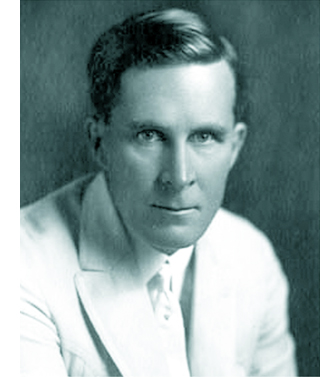 William Desmond Taylor’s place in film history is secure, but not because of his movies. His 1922 murder galvanized the nation. Suspects included stars Mabel Normand and Mary Miles Minter, Minter’s mother, an embezzler, an estranged brother, bootleggers, drug pushers, blackmailers, and assorted low-lifes. The case reeked deliciously of scandal.
William Desmond Taylor’s place in film history is secure, but not because of his movies. His 1922 murder galvanized the nation. Suspects included stars Mabel Normand and Mary Miles Minter, Minter’s mother, an embezzler, an estranged brother, bootleggers, drug pushers, blackmailers, and assorted low-lifes. The case reeked deliciously of scandal.
Minter was infatuated with him, her mother owned a .38, and Taylor’s secretary had absconded with a car and forged checks. Speculation spread in many directions. Was Taylor gay or bisexual? Was he a drug addict, or a supplier, or someone trying to rescue a friend from addiction? Did Mary and Mabel quarrel over his affections? Who was his late-night male visitor? Did the bungalow actually contain tagged items of ladies’ lingerie, and pornographic photos of Taylor cavorting with starlets?
For nearly a hundred years fans and tabloid TV have returned obsessively to the murder. Even King Vidor began sleuthing late in life with the aid of Colleen Moore.
Taylor cut quite the figure. Tall, handsome, and solemn of mien, he left Ireland and led a barnstorming life in America. He abandoned a wife and daughter in New York to take up touring stage work. He wound up in Hollywood. After some acting successes, he directed shorts before graduating to the popular serial The Diamond from the Sky (1915). His feature films were widely respected, and he became a key figure in forming the Directors Guild (then the Motion Picture Directors’ Association).
Okay, it makes a swell mystery. But what about Taylor’s movies?
The other sort of teenpix
Back in 1976, Richard Koszarski had the very good idea of mounting a program called The Rivals of D. W. Griffith for the Walker Art Center. Auteurism was at its height, so it’s no surprise that the program’s subtitle was Alternative Auteurs: 1913-1918.
Remember, this was before all those festivals that today specialize in exhuming silent classics. Beta and VHS had just been introduced and were not yet popular. There was no Criterion, Flicker Alley, or TCM, or any other platform that would give these old movies a mass-market afterlife.
Since then, things have improved a lot. We can now see on video nearly everything in Richard’s show: Wild and Woolly, Stella Maris, Juve vs. Fantômas, The Italian, Hell’s Hinges, The Mysterious X, Straight Shooting, The Gun Woman, Behind the Screen, The Rink, The Immigrant, The Outlaw and His Wife, The Cheat, and The Blue Bird. Some of the copies are shabby, but they’re out there. Anyhow, collectors’ 16mm dupes that circulated back in the day were hardly impeccable.
The program helped balance out historical accounts. Richard’s opening essay in the program’s catalogue flung down the challenge. Most historians had ignored the period, but:
Even the most casual investigation must reveal the years 1913-18 as the most hectic, tumultuous and progressive in the entire history of the cinema.
Richard’s aim wasn’t to attack Griffith. This was a time when cinephiles were discovering the superb Biograph shorts, and appreciation of his artistry was expanding. Instead, Richard usefully reminded us of all the other things going on as features emerged.
Looking at the films in this program will help anyone appreciate even more fully Griffith’s strengths, and pinpoint more certainly his weaknesses. Often his individual achievements will be matched, sometimes surpassed.
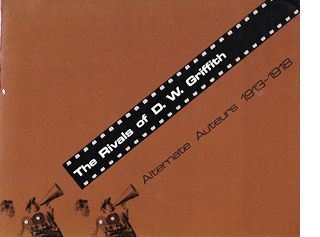 Richard’s introduction ably sums up the changes in the industry that made the period so fertile. And the contributors’ notes that follow, while brief, point up valuable things about the program. The Rivals of D. W. Griffith is still very much worth having.
Richard’s introduction ably sums up the changes in the industry that made the period so fertile. And the contributors’ notes that follow, while brief, point up valuable things about the program. The Rivals of D. W. Griffith is still very much worth having.
My recent investigation of nearly a hundred U.S. features from the period wasn’t exactly casual, but it seems merely a depth sounding of a vast body of extraordinary work. I’ve offered you glimpses of it in earlier entries (here and here and here), but there’s a lot more I’d like to share.
Which brings me back to William Desmond Taylor. He doesn’t figure in Richard’s Rivals show, probably because few of his films were available. Most of his work is lost. He signed forty features between 1915 and 1922, of which seventeen apparently survive, many incomplete. Most of those I’ve seen are solid but not dazzling. The amiable Tom Sawyer (1917) is a good example of how polished Hollywood cinema already was in 1917, and the leisurely Mary Pickford item Johanna Enlists (1918) is ingratiating as well. At the film’s climax Taylor tries for triangular staging of the type that would come in the 1920s, but he botches it with mismatched eyelines and screen directions. By the time of The Soul of Youth (1920), a touching movie about juvenile delinquency, the cutting is very meticulous, as in Huckleberry Finn (1920). Both films use startlingly tight close-ups, some of them shot with a wide-angle lens.
Taylor also claimed innovations in visual narration. His now-lost Sacred and Profane Love (1921) was promoted as including scenes in which an expository title rises up over character action, makes its comment, and melts away while the scene continues. Perhaps the opening of The Soul of Youth was a step in this direction. In chiseled silhouettes we see an unwed mother selling her baby to a gangster’s girlfriend, introduced through “art titles” dissolving away to reveal the action.
The Soul of Youth also includes some embedded scene movement in the corners of titles. Such experimentation with intertitles was a trend of the period.
So we have a director of some ambition. That inference is backed up by some flashy moments in earlier 1910s work. In 1916 Taylor released a remarkable nine features, and during my DC stay I saw what remains of four of them. Although they’re in parlous shape, they show a lively pictorial and dramatic intelligence. Are they auteur films in the strong sense? At least we can say that Taylor, like many other directors, was channeling just that exuberant creative energy that Richard evokes. Certain moments in two of these movies have genuine flair, and one film is an all-out stunner. I had never heard of any of them.
1916 and all that
My first 1916 title is Pasquale. It stars George Bevan, famous for his stage roles as good-natured Italians. It’s a story of friendship betrayed. Two immigrants who return home to fight for Italy are shown to be more honorable than the American men who cheat them and beat their women.
“A mighty good feature,” said Variety’s reviewer, but you can’t prove it by me. The Library of Congress print lacked the first and last reels, and what was in between consisted of scenes and parts of scenes jumbled up. While it’s certainly competent, I didn’t see much subtlety in its staging or cutting. The use of crosscutting to tie together its story lines was standard for the period.
The print of the Civil War story Her Father’s Son was a little scrambled too, and it lacked the final reel, but it was more coherent. A girl from the North must pretend to be a boy—first, to satisfy an old Southerner’s urge for an heir, then after the war starts she is pressed into service as a courier, and eventually a sterling supporter of the confederacy. The most noteworthy bit of technique, I thought, involved the varied camera setups in one scene. Frances (Vivian Martin) is asked by her dying father to go live with his brother as a boy. The changes in shot scale and angle emphasize her moment of decision, as well as her reaction to her father’s death.
This passage shows more flexibility of camera setup than Griffith displays in the sequences in the Union hospital in The Birth of a Nation (1915), or in Intolerance, from the same year as Taylor’s film. Taylor here joins a general push toward finer-grained analytical editing in dialogue scenes. Other examples are Reginald Barker’s The Bargain (1914) and DeMille’s The Cheat (1915).
The House of Lies is more flamboyant and peculiar. Edna is an ethereal girl who likes waterfalls, poetry, children, and rabbits. Her stepsister Dorothy is vain and soulless. Mrs. Coleman is determined to marry both off to wealthy men. Refusing to trade her beauty for social position, Edna splashes her face with acid. She becomes the secretary of the sensitive author Marcus Auriel. But the stepmother is plotting to snare him for Dorothy, while also joining forces with a thief who wants to steal a financial document from Auriel’s safe.
Variety considered The House of Lies a good example of “what a feature picture should not be.” The reviewer considered it old-fashioned melodrama. Fair enough, but it doesn’t creak much and has considerable visual fluency. Sometimes there are echoes of the tableau style, as when Edna steps aside to reveal her sister and stepmother dressing in the background.
But the same tableau setup gets overridden by the sort of axial cut so common at the period. Earlier in the scene when the stepsisters get dressed for the big party at which they’ll be displayed, instead of letting Dorothy step aside to reveal the other women, Taylor “cuts through” Edna’s blocking figure to the women behind her.
The transition would be jumpy were it not for a (mispunctuated) title: “I don’t understand all this display mother; when we should still be in mourning for father.”
A variant of the axial cut employs a 180-degree reversal. We’ve already seen Edna’s reluctance to enter “the auction” at which rich men will look her and Dorothy over. She pauses at the doorway, which in wealthy houses of this period always seem to be covered with a heavy curtain.
Later, after her mother has taken Dorothy around to meet her guests, we see the poet Auriel remark to a friend that it’s like a modern slave market. Cut to the opposite side of the men to reveal Edna’s reaction to his line.
It’s this that drives her upstairs to destroy her beauty.
The acid-splashing is of course the grisly high point of this drama. It’s handled with what at first seems a tactful obliqueness.
Mrs. Coleman has summoned a maid to bring Edna back to the gathering. As she enters, Edna stands at the mirror, pondering. Since Dorothy is the sister associated with mirrors, this seems out of character for Edna.
Seeing the maid, she picks up the bottle of acid. Before opening it, she experimentally rubs her face.
A closer view of her at the mirror shows her ostentatiously lifting the bottle, as if making sure the maid sees it. In retrospect, it may be that she’s staging the scene for an eyewitness.
Cut back to the original bathroom framing as Edna seizes her cheek and cries out. She runs into the next room, as seen in the reflection.
A nice match on action brings Edna into the boudoir, where she collapses.
Thereafter Edna sports a ravaged cheek or a discreet bandage. Eventually Auriel declares that he loves her despite her deformity. She then reveals that her scar is mere makeup. She never really applied the acid. She wanted out of the marriage auction and sought someone to love her for herself.
Taylor’s framing and cutting conspire with Edna to conceal her deception. Mirrors create spatial trickery in 1910s films from both America and Europe, often doing duty for reverse angles or POV cutting. The embedded image usually serves to expand what we know, as it does here.
But Taylor’s mirror reflection also makes the maid into a decoy, teasing us to watch her as well as Edna. Hiding what Edna was up to would have been more obvious if we didn’t have the maid to distract us. Of course Taylor could simply have cut away from Edna at the crucial moment, but that wouldn’t carry as much conviction as seeing an apparently full, if discreet, shot of the self-mutilation.
A noir western?
Noirish westerns like Duel in the Sun (1947), Pursued (1947), and The Furies (1950) revolve around dysfunctional families, tyrannical patriarchs, childhood anguish, and sadistic corruption. Somewhat in this vein is one of the story lines that inform Taylor’s Ben Blair (1916). The noirish action is embedded within a larger plot involving the clash of New York decadence and prairie rectitude. As a bonus, certain scenes evoke that proto-noir style I considered in an earlier entry. One scene of violence is spectacularly beautiful—Ford meets Mann, shall we say, before both showed up.
The film roughly follows the plot of the 1905 novel. When Tom Blair’s common-law wife dies of illness and neglect, he sets fire to his ranch house in an effort to destroy her corpse and kill her son Ben. The boy escapes and is adopted by the good-hearted rancher Rankin. Ben grows up alongside Florence, daughter of another rancher. When Flo’s father dies, his widow takes Flo to New York in search of a husband for her. In the meantime, Tom Blair has returned and is raiding local ranches for horses. He shoots Rankin, and Ben sets out to avenge both his mother and his benefactor.
The second half of the novel, and the film, brings Ben to New York. He finds Flo captivated by the urbane but unstable Clarence Sidwell. After Ben sees the depravity of city life, he tries to lure Flo away.
Second things first. Critics found the New York section of the book less evocative than the Western half, but such can’t be said for the film. An eyebrow-raising introduction to the rake Sidwell leaves little to the imagination.
Flo had told Ben she wanted to leave the West for “the things of civilization.” Now we get a title: “The things of civilization. Exhibit 1: Clarence Sidwell.” Fade in on a louche creature pouring himself a drink.
Shock cut back: In an extreme long-shot, a young woman bursts out from the distant bedroom, dodges Sidwell, zigzags desperately through the vast parlor, and hurls herself out of the foreground.
As the deep space of 1910s cinema becomes an obstacle course, we’re obliged to understand that the poor woman has been raped. The power of the scene comes from her frantic rush toward us in contrast with Sidwell’s bored calm.
When she collapses in the next room, he moves as if to follow her, then shrugs and returns to his post-coital drink. In the novel, Sidwell is a neurotic workaholic, nothing like this chilling libertine.
A parallel scene occurs later, when Ben has come to Manhattan to visit Flo. On the street at night, he chivalrously agrees to see a woman to her apartment, only to find that he’s been tricked into visiting a brothel.
As in the novel, he shoots his way out (these sissies can’t handle him), but not before he glimpses Sidwell there with a floozy. This, along with Sidwell’s rape of the woman we’ve already seen, reminds you of what all those censors were complaining about in the era of scandals around Fatty Arbuckle, Wallace Reid, and other Taylor contemporaries.
Ben learns that Flo has agreed to marry Sidwell, and Ben’s memory compares the brothel revelation with Flo’s farewell to him back on the ranch.
He must save her from this man.
Ben is too honorable to snitch on Sidwell. He simply walks in the family mansion and tells Flo that she is leaving with him in half an hour, or he will kill Sidwell. He counts on her underlying love for him and their childhood home. After her indignation dies down, she agrees happily to go “back to God’s country.”
The tension of the film’s first half centers on Tom Blair’s murder of the genial old Raskin and Ben’s pursuit of Blair. Tom, it turns out, isn’t Ben’s biological father; Raskin is. Tom has killed Ben’s mother through abuse and his natural father through homicide, so the son’s quest gains mythical overtones.
There are some majestic vistas, along with flashy exchanges of gunfire among rocks. The clincher comes when at the height of their fistfight, Ben is ready to strangle Tom and bends over him. The false father gasps for mercy.
A brutal cut takes us to Ben’s eye, which fills with the image of Florence.
We realize that he couldn’t face Flo if he murdered a man in cold blood. So he lets Tom live, drags him back to town, and even saves him from a lynch mob. But this moment—in 1916, remember—shows how eager filmmakers of this period were to maximize the emotional power of a scene. Often we’ll find that an expository title and a bit of facial emoting has been replaced by tactics of cutting, framing, and here, precise special effects.
Devil’s doorway
Skilful backlighting is more precious than a gallon of peroxide!
William Desmond Taylor
This isn’t the film’s only prefiguration of the noir hero driven to the brink. Ben has nearly lost control earlier in the film, and this scene involves the noir look as well. It grows out of Tom Blair’s cold-blooded murder of Raskin.
In the novel, Ben witnesses it from the barn, but he’s too late to catch Tom before he rides off. In the film, Ben is in town, seeing off Flo and her mother at the train. Now the scene is played out for us, with the cook as an appalled side participant.
Hearing noise in the corral, Raskin steps out on the porch. The edge lighting outlines him vividly enough to be visible, and cut down.
A 180-degree reverse shot puts us inside as the cook rushes to the door and peers out.
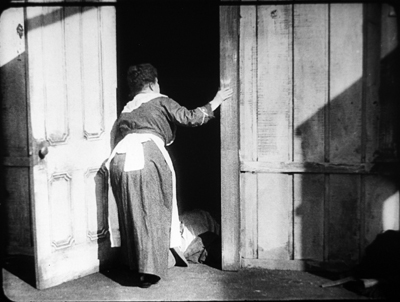
Cut 180 degrees again to a variant of the first shot, framing the bunkhouse in long shot. After a beat, Tom Blair and his horse appear in the foreground. The lighting here is of remarkable delicacy: the silhouettes are barely picked out.
We return to the shot inside the bunkhouse. Another beat: The face of the man passing emerges as she turns away in horror.
Tom mounts his horse and rides off. Soon, in another shot from outside, the ranch workers gather at the doorway, as Ben arrives with his horse. One standard option would be to have the dead man carried in, to have the men assemble around the body, and in clear light and shot/ reverse-shot, to show Ben issuing his orders. Instead, Rankin’s body lies blocking the threshold and all the action is played in the bright rectangle and made emphatic by axial cuts.
The first cut comes as Ben reacts to what has happened. He’s in darkness, with the cook and cowpokes watching.
Ben tells them to take care of Rankin: “Put up your guns, boys–This is my affair.”
When one of the men accuses him of trying to cover up for his father, Ben explodes and starts beating him. A cut in to a closer view shows him strangling the offender. As in later cinema, the abrupt cut accentuates the violence of Ben’s attack.
An axial cut back shows the victim protesting: “Let up–I didn’t mean it!” Ben shoves him aside and bends over the dead man sorrowfully.
The ranch hands carry Rankin’s body in. Ben is left in the doorway brooding on what he must do to avenge the death of his surrogate father.
Call it Fordian if you want. I wouldn’t object.
Given the fame of Dustin Farnum as a star at that moment, it seems fairly daring to subordinate a dramatic high point to this incisive visual design, with all the action squeezed into the doorway. Stance and gesture have replaced close-ups and facial reactions. The scene varies so much from the book that we might want to credit the scenarist, Julia Crawford Ivers. Ivers, who who had directed films herself, collaborated closely with Taylor on his projects. The cinematographer, perhaps Homer Scott (another Taylor mainstay and a significant DP before 1923), may also have had a big say in this virtuoso scene. The film could claim its “Lasky lighting” as typical of the Paramount brand.
All of Taylor’s surviving films I’ve seen are of interest; he’s clearly one of the more talented directors to give up the tableau and work in the continuity style that would define Hollywood. In particular, Ben Blair would definitely be worth reconstructing and restoring. The LoC print, while jumbled in its last two reels, is fairly complete, and the shots could be rearranged coherently. At the risk of spoilers, I wanted to share with you my discovery of this exciting piece of work. Taylor deserves to be remembered for more than his fate that night in February 1922.
Thanks again to the John W. Kluge Center for providing me a long stay at the Library of Congress. The Moving Image Research Center was my host, and so I’m grateful to Mike Mashon, Greg Lukow, Karen Fishman, Dorinda Hartmann, Josie Walters-Johnston, Zoran Sinobad, and Rosemary Hanes. They’re doing a wonderful job. Special thanks to Richard Koszarski for background on his Rivals program, and to Alan Gevinson for discussions of 1910s cinema generally and Taylor in particular.
Relevant to this entry is Kristin’s article is “The International Exploration of Cinematic Expressivity,” in Film and the First World War, ed. Karel Dibbets and Bert Hogenkamp (Amsterdam University Press, 1995), 65-85. She discusses American lighting practices of the period in The Classical Hollywood Cinema: Film Style and Mode of Production to 1960 (Columbia University Press, 1985), 223-227. See also Lea Jacobs’ article “Belasco, DeMille and the Development of Lasky Lighting,” Film History 5, 4 (December 1993), 405-418.
Some Taylor films are available on DVD. The most authoritative is the beautiful restoration of The Soul of Youth that’s included in Treasures of American Film Archives vol. III: Social Issues in American Film 1900-1934. Tom Sawyer is available in a fairly good copy, as is Huckleberry Finn, which doesn’t survive complete; it has played on TCM in a tinted version. Copies of Johanna Enlists and Nurse Marjorie are problematic but watchable.
Ben Blair was mostly liked in the trade papers, though Variety claimed that the film was “hardly up to the Paramount standard.” But using the same phrase, Manhattan’s Broadway movie theatre declined to show it. You wonder if the Sidwell rape scene had something to do with the decision. After some wrangling, the management cut it to two reels and “used it as ‘filler.'” Tastes do change.
On Taylor’s career, see Richard Koszarski, “The William Desmond Taylor Mystery,” Griffithiana 38/39 (October 1990), 253-56. The most authoritative reference on Taylor’s life is Bruce Long’s collection of clippings and commentary William Desmond Taylor: A Dossier (Scarecrow, 1991), from which my backlighting quotation comes (p. 162). Alan Gevinson’s filmography in Long’s book is the most comprehensive I know. Long also ran the online publication Taylorology, which offered exhaustive coverage and analysis of the murder.
Speaking of the murder, there’s enough material in books and online to keep aficionados busy for years. Whodunit? Since this entry is spoiler-filled, I’ll summon a lineup. The principal books on the case finger four suspects: Mary Miles Minter’s mother (favored by King Vidor, as reported by Kirkpatrick); Mary herself (Higham); a hitman for a drug gang (Giroux); and one of a trio of blackmailers (Mann). Long’s Dossier lists many errata in the first two of these. Of these, Giroux’s is the most sober and avoids High Tabloidese, as well as the confident reporting of the thoughts and feelings of people long dead. My own hunch is that too much evidence has been destroyed to permit a plausible conclusion.
Still, the Taylorologists have supplied fascinating information on what Hollywood culture was like at the period. It still astonishes me that celebrities like Taylor, Minter, and Edna Purviance could live without bodyguards and security, while Mabel Normand could just stroll down the street to buy a bag of peanuts. And all chroniclers agree that the studios kept a lid on an investigation that law enforcement conveniently botched.
A quick and entertaining overview of the scandal is Rick Geavy’s graphic novel Famous Players: The Mysterious Death of William Desmond Taylor (NBM, 2009).
Okay, I can’t refrain from going a bit sleazy too. Below is a drawing of the crime scene from a newspaper of the period.
P.s. 4 January 2021: Add Erle Stanley Gardner to the list of distinguished investigators of the crime. His “1922: William Desmond Taylor,” summarizing press reports and offering some speculative inferences, appeared in Los Angeles Murders, ed. Craig Rice (Duell, Sloan and Pearce, 1947), 83-119.
Thanks to Taylorology and The Silent Era.
Film noir, a hundred years ago
A Romance of the Air (1918).
DB here:
One of the most persistent conventions in American cinema associates dark images with dangerous doings—crime, mystery, violence, espionage, sexual depredations, visits from beyond the grave. The strategy is most apparent in what critics eventually called film noir. Those 1940s “films of darkness” are sometimes said to derive from German Expressionist cinema, but the look was already a Hollywood tradition. Filmmakers had long treated scenes of mystery and suspense with hard, low-key lighting that yielded rich chiaroscuro.
When does it start? You can find very early examples, but it seems to have crystallized during the 1910s. Kristin has talked about this as a period when filmmakers were collectively struggling to tell somewhat lengthy stories in a clear fashion. Along with clarity, she argues, came efforts to add emotional impact to a scene. Those included dynamic staging, fast cutting, close-up framings, subtle but arresting performance styles, ambitious camera movements, and lighting that enhanced the mood of the action. She points to many European and American films of the years 1912-1916 that flaunt silhouettes and selective lighting.
I found a lot of prototypes of noirish images during my recent trawling through Library of Congress films from 1914-1918. In this era, it seems, filmmakers competed to create striking, even shocking, lighting effects. Later directors and cinematographers would adopt many of them as proven tools for boosting their scenes’ emotional power.
So today’s entry is mostly just some pictures that try to convince you, once more, that the 1910s laid down a great deal of what we take for granted in films ever since. You may want to turn up your display. We’re going dark.
No sunshine here
Start with the shot up top, from the independent production A Romance of the Air (1918). Produced by and starring Bert Hall, flyboy and author of the source book, it traces how German spies posing as French refugees win his confidence and try to steal secrets about troop movements. It was released in the month of the Armistice, and it got what appears to be a welcome reaction from audiences.
A Romance of the Air, nearly amateurish in its opening stretches, gets more competent as it goes along. But there’s only one real uptick from a pictorial viewpoint. Two spies have attempted to gas Edith, Bert’s sweetheart, but fortunately their incompetence leads them to the wrong room. They meet outside the house, and suddenly we get a shot that had me hollering.
As the man lights a cigarette, a low-slung angle shows the flare of the match illuminating his hatbrim and the countess beside him. In the upper left Edith peers down from a window. We might be in Hollywood, 1945, perhaps in the hands of production designer William Cameron Menzies or ace DP John Alton.
It’s interesting that a title pops in here, coaxing the audience to notice the face at the window.
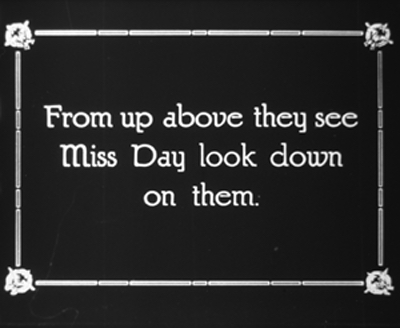
The mistaken placement of “From up above” tells you something of the clumsiness of this whole production. Yet bad grammar is redeemed when we return to the framing as the spies twist around in surprise and the man clutches the countess.
Other filmmakers of the period would have trusted the audience to spot Edith, but nonetheless an undistinguished, forgotten film bequeathes us one bold moment.
We can see a more conventional look emerging when characters get sent to jail. By the end of the 1920s, filmmakers had found a way to crosslight cell bars to make them stand out crisply, as here in von Sternberg’s Thunderbolt (1929).
A jail scene in The Unknown (1915) isn’t so flashy, but the concept of edge-lighting the bars is there. If all you wanted was clarity, the naked cell door suffices, but the sidelight makes the barrier more vivid.
At this point, some directors were willing to leave large patches of the image in darkness, even at the risk of off-balance compositions. This is not only expressive; it saves money on set construction. So trust Maurice Tourneur to go further. In Alias Jimmy Valentine (1915), one of the most accomplished films of the era, we get cons as patient silhouettes.
No need to see their expressions; the outlines of their poses express their resignation.
Speaking of prisoners, consider the plight of Ivanoff, the revolutionary who has been sentenced to Siberia in Cecil B. DeMille’s The Man from Home (1914). He has escaped from the mines and taken refuge in a stable. Filing off his chains, he crouches as guards pass by outside. First, he’s in a glare, but when he hears them….
… he shifts into semi-shadow.
The guards’ approach is measured by a barely noticeable change: the gleaming surface on the far left is briefly darkened.
This is a bold instance of “Lasky lighting,” the brilliant effects which DeMille worked up with Wilfred Buckland, Belasco’s stage designer. Several films in my sample exemplify this style, which became part of Jesse Lasky’s Paramount brand. Examples are comparatively abundant because many Paramount films have survived from the silent era.
Camera obscura
In A Romance of the Air, the darkness is motivated as a night scene, and naturally prisons and hiding places are associated with danger. Another option is to stage scenes in darkened rooms, populated by sneaking and skulking characters. Again, the association with criminality is evident. In Alias Jimmy Valentine, hoods hide from cops and are visible thanks to diagonal edge lighting.
More dynamic are two suspense scenes in Madam Who (1918), the story of a plucky Southern belle who goes undercover for the Confederate cause. In the first, disguised as a man, she peers down from a hayloft to watch the meeting of the Sons of the North gang. We get an optical POV shot straight down, and then a close reaction shot, with a fish-hook of light snagging her face as she glances at us.
Reginald Barker, one of the most resourceful directors of the era, didn’t let up in a later scene of Madam Who. Jeanne and the secret agent Henry Morgan get the drop on the Sons’ leader Kennedy. The action plays out in layers of darkness, with her poking a pistol through the doorway right of center, and it’s capped by a stark close-up.
In the late 1910s, several directors use such darkened interiors for fight scenes. In De Luxe Annie (1918), the heroine’s husband takes a brutal beating from the criminal he’s trapped. The accomplice runs to administer a hypodermic.
Something similar happens in The Family Skeleton (1918), when dissolute Billy (Charles Ray) battles the bully who has tormented him throughout the movie.
Shadow-filled rooms help amp up suspense during fistfights. We can’t be sure who’s winning, and the enveloping darkness can also suggest more savage violence than could be shown in normal light.
Or you can stage a fight or a chase in a darkened area outdoors. The Sign of the Spade (1918) sets its climactic abduction and rescue under a seaside pier, and the silhouettes that result would not have shamed Panic in the Streets (1950).
As with the jail in Jimmy Valentine, we have to read the characters’ emotions–chiefly, the desperation of the fleeing woman–from their body language. And as often happens, the more we have to strain to see the action, the more gripping it becomes.
Billy and two Annies
De Luxe Annie (1918).
Of course what we call film noir includes more than visual style. Like many terms in the arts, film noir picks out a cluster concept. It links together distinctive subjects (urban life, abnormal mental states, misogyny), attitudes (alienation, nihilism, malaise, mistrust of authority and the upper class), themes (official corruption, revenge, male friendship and betrayal), plots (investigation, pursuit, deception), narrational devices (flashbacks, voice-over commentary, dreams and hallucinations), and visual techniques. Because noir is a cluster concept, eager acolytes can choose some noir-ish qualities of Film A and declare it a more or less plausible instance, while with Film B a quite different set of features might help it qualify too.
For example, in visual technique, only a few shots of Laura carry traces of the lighting style we think characteristic of noir. But the film does present a decadent, treacherous milieu harboring a mysterious, perhaps dangerous woman who may be feeding a man’s delusions and obsessions. Laura, I’d suggest, counts as a noir on thematic and narrative grounds more than on stylistic ones.
So do we find non-stylistic features of noir in the 1910s? Sometimes, yes. I’ll save my prime example, an intricate and beautiful thing, for an entry of its own. But here are two nifty cases where the visual pyrotechnics spring from noirish narrative and thematic pressures.
Billy Bates is warned that alcoholism runs in his family, but on getting his inheritance he holds a party and learns that he likes the stuff. Not needing to work, he keeps drinking. He falls in love with chorus girl Poppy Drayton, but when she’s insulted in a saloon he’s too crocked to defend her from the hulking Spider, who beats and shames him. Billy learns that Spider is planning to abduct Poppy and so lays a trap. He waits in Polly’s parlor, resolving to stay sober long enough to defend her. Unfortunately, there’s a decanter of scotch within easy reach….
The Family Skeleton (1918) was touted as a “semi-farcical production” but the semi- parts took alcohol addiction fairly seriously. The popular Ray often played the country-boy underdog, so audiences were probably unprepared to see him as a millionaire twitching from the D.T.’s. The scenes of his drunkenness are truly unnerving, even when the plot is lightened by the revelation that Spider is a detective hired by Poppy to force Billy to man up. Billy does, in the nocturnal fistfight illustrated above. There darkness makes Billy’s ultimate victory more plausible; we can’t really see his winning punches.
In the buildup to the fight, however, we get Billy’s growing anxiety over the scotch across the room. He stares at the decanter.
A cut shows us a condensed mental image: what would happen if he drank the contents. In this hypothetical future, the decanter is empty, and in it we see Spider breaking in and carrying off Polly while drunken Billy lolls helplessly.
As in the hallucinations of The Lost Weekend (1945), the filmmaker has taken us inside the addict’s fantasy.
Other subjective effects, like memories and dreams, were common in silent cinema too, though usually not plunged so deeply in darkness. In De Luxe Annie, Julie Kendall is worried that her husband is taking a risk by setting a trap for two dangerous swindlers. He will pose as an innocent mark and then arrest them when they try to con him. Julie’s concern emerges in a virtuoso split-screen dream sequence in which her husband is shot by the crook.
Later in the film, Julie will lose her memory and become the con man’s confederate, the new De Luxe Annie. The screenwriter’s old friend amnesia transforms an upper-class wife into down-at-heel swindler.
What triggers the amnesia? The most remarkable scene in the film. It’s either a brilliant coup or a happy accident, but either way it can stand as proof of the boiling energies of this era.
Worried about her husband, Julie follows him to the site of his trap. She goes in through the basement kitchen and enters almost total blackness. She stands in a tiny pool of light before a big double door, and it opens a crack.
Suddenly, and I mean instantly, the doors are wide open and we get a burst of light.
A jump cut has eliminated the movement of the doors swinging apart. (You can see the splice at the bottom of the second frame and the top of the third.) This is a very bold stylistic flourish.
Kristin suggests that it’s something of an accident. The overhead kitchen light is now lit up, and it was common at the time to cut out some frames when a light source is snapped on. That may be what led to this jump cut, though it’s not clear how anyone in the scene could have hit the power switch. In any event, the force of the cut is amplified by the ellipsis; the doors simply pop open.
Another pictorial surprise emerges when Julie moves a bit and it’s revealed that her figure has blocked De Luxe Annie, who’s facing her over the threshold. They start to grapple with one another and move into darkness on the right.
Annie runs off, but Jimmy the con man is fleeing too, and he shows up to wrestle with Julie. A slamming axial cut shows him punching her fiercely in the head. The edge lighting here is remarkable.
Jimmy gets away, leaving Julie to stagger out and into the fog. She’s contracted amnesia. Later she’ll meet Jimmy again and become his new partner in crime.
This scene is even replayed as a brief flashback, when the original Annie recounts to Jennie’s husband the clash that led to Julie’s disappearance.
This is presented in a more unsurprising way, since there’s nothing new to be learned about the fight. The shot shows the full swinging open of the doors and a clearer revelation of Annie’s presence.
All this won’t be news to aficionados of silent film, who are well aware that the 1910s, and then the 1920s, burst with ingenious creativity. But everybody needs reminding, and the rare films I was lucky enough to study are just part of a huge corpus. The official classics by Chaplin and Griffith and others can be restored and reissued again and again, and we’re grateful. Yet if they’re the peaks of a landscape, there are plenty of luscious valleys that remain unexplored.
Problem is, most of the films from which my scenes come are incomplete, often missing entire reels. So they’ll probably never be screened much, or made available on DVD or streaming services. This is why archives remain indispensable to keeping the entirety of our film heritage, fragments and all, available to researchers. It’s also why I wrote this entry, to share with you my enjoyment of films you may never have a chance to see.
More broadly, scenes like these help us nuance our thinking about those films we do know well. For one thing, they indicate just how rich the creative energies of the 1910s were, and how many options were not embraced by…oh, let’s say for example D. W. Griffith.
For another thing, if these neglected works throw up willy-nilly an alcoholic’s hallucinations, an anxious wife’s dream, a plot based on amnesia, and a strategic replay of a crucial scene, we ought to think twice about claiming that such storytelling strategies are somehow unique to film noir, or the zeitgeist of the 1940s–or our movies today, which continue to use them.
American commercial cinema has drawn on particular themes, plot structures, formal designs, and narrational strategies again and again throughout the decades. My book Reinventing Hollywood floats the claim that silent-cinema narrative devices like flashbacks and subjective sequences went somewhat quiet during the 1930s but were brought back fortissimo in the 1940s, when sound techniques could raise them to a new level of intensity. And I’ve been at pains to argue over the years that we still encounter them.
Again, no surprise once we think about it. This is just history at work: the continuity of a powerful, proven storytelling tradition. Once we’ve learned to love darkness, we can’t give it up.
Again I must give my thanks to the John W. Kluge Center for providing me a long stay at the Library of Congress. The Moving Image Research Center was my host, and so I’m grateful to Mike Mashon, Greg Lukow, Karen Fishman, Dorinda Hartmann, Josie Walters-Johnston, Zoran Sinobad, and Rosemary Hanes. They’re doing their utmost to preserve our film heritage.
For information on the survival of US silent films, download David Pierce’s indispensable study, done for the Library of Congress. The information on Paramount is on p. 41.
Kristin’s article is “The International Exploration of Cinematic Expressivity,” in Film and the First World War, ed. Karel Dibbets and Bert Hogenkamp (Amsterdam University Press, 1995), 65-85. She discusses American lighting practices of the period in The Classical Hollywood Cinema: Film Style and Mode of Production to 1960 (Columbia University Press, 1985), 223-227. In the same volume in discussing film noir I consider the established practice of chiaroscuro for scenes involving crime and mystery (p. 77).
The most in-depth account of Paramount’s lighting styles is Lea Jacobs’ article “Belasco, DeMille and the Development of Lasky Lighting,” Film History 5, 4 (December 1993), 405-418. This is a good place to record my deep debt to Kristin, Lea, and Ben Brewster, for years of tutelage in what makes the 1910s so important.
There are many good books on film noir, but the most comprehensive reflection on the category’s many implications is James Naremore’s More Than Night: Film Noir and Its Contexts, 2d ed. (University of California Press, 2008).
For more on 1910s film style, see this video lecture and this category of blog entries. I talk about other forays into the LoC collections here and here.
Lately, two video distributors have brought out less-known films from the period. There’s DeMille’s The Captive (1915) from Olive, and Irvin Willat’s Behind the Door (1919). The somewhat noirish frame below is from the latter. Flicker Alley, whose commitment to silent cinema from all countries has been extraordinary, deserves our thanks for making the San Francisco Silent Film Society’s restoration of this sensational, and sensationalistic, film available. For more on this restoration, visit the Flicker Alley site.
Behind the Door (1919).












